Sarah Tarhini • 30 Jul 2022
17 unforgettable experiences you can have in bekaa.
Celebrated for its beautiful landscapes and picturesque roads, Bekaa is rightfully one of the most beautiful sites in Lebanon. Whether you’re visiting the area or just passing by, check out these 17 lovely experiences you can have exclusively in Bekaa!
1. Gaze at the marvelous Umayyad Ruins in Anjar
2. Enjoy a day of wine tasting at Chateau Ksara, Zahle
Learn about winemaking, the ancient wine cellars, scenic vineyards, and wine tasting in the homeland of Lebanese wine.
3. Visit the largest freshwater wetland in Lebanon, Ammiq Wetland
4. Get an eyeful Lake Qaraoun
5. Behold a glimpse of paradise in West Bekaa
6. Catch sight of nature’s wonders at Taanayel Lake
7. Check the dazzling sun temple, the Haidara Ruins in Qabb Elias
Local legend says that there was once a mirror on the face of the building that used to reflect sunlight down into the village for sun-worshiping Roman practices.
8. Travel through the picturesque Kamed el Louz village in West Bekaa
9. Marvel at the beauty of Ain Aata’s sunrises
10. Explore the magnificent historic monument, Temple of Ain Hercha
11. Take in the breathtaking views of Oyoun Orghoch
Encircled by the rocky hills of Qornet Al-Sawda, the highest mountain in Lebanon, Oyoun Orghosh is a charming town abundant with springs and ponds.
12. Feel the adrenaline rush with Bekaa’s extreme sports
Bekaa is a main attraction for all extreme sports lovers like biking, hiking, cycling, and skydiving.
13. Take a trip to one of the oldest wineries in Lebanon, Chateu Kefraya
You can enjoy some wine tasting, a guided tour in the vineyards, and a lunch at their beautiful restaurant.
14. Immerse yourself in delicious food and mesmerizing views at Wadi Chamsin, Barr Elias
15. Get to know the wildlife in Aana Deer Reserve, West Bekaa
16. Wander through the magnificent architecture in Rashayya village

17. Visit the holistic site of Lady of Zahle


Guides 24 Jun 2024
Hidden gem alert: an island restaurant off the coast of jbeil, all the concerts happening in july around lebanon, guides 22 jun 2024, we found the dreamiest mykonos-inspired guesthouse in batroun, guides 21 jun 2024, l'auberge de tyr: a beckoning summer escape, guides 20 jun 2024, for the first time in lebanon, a waterpark in the middle of the sea, 23-year old lebanese powerlifter shatters world record, crunchy sip: hamra's new cereal and ice cream spot, 13 spots making the yummiest soft serve ice cream in lebanon, 15 savage comebacks you've heard from your lebanese dad, these are the ticket prices for sherine's concert this summer.
Our head office
0800 088 6002, [email protected], client log in, reset password, agent log in.

Exploring the Enchanting Temples of the Beqaa Valley (Bekaa Valley): A Journey Through Lebanon's Historic Wine Region
Nestled in Eastern Lebanon lies a region where history, culture, and natural beauty converge in perfect harmony. Join us on an enchanting journey through the Beqaa Valley, also known as the Bekaa Valley, as we unveil the secrets of its ancient temples and delve into the rich tapestry of Lebanon's historic wine region.
This captivating adventure promises to take you on a voyage through time and taste, where vineyards and ancient ruins coexist, inviting you to explore the wonders of this remarkable corner of the world.
Embark with us on a voyage through Lebanon's past and present, where each step reveals a new layer of this enchanting tale.
What Is the Beqaa Valley, and Why Is It Significant in Lebanese History?
The Beqaa Valley, often referred to as the Bekaa Valley, is a region in Lebanon nestled between the Mount Lebanon and Anti-Lebanon mountain ranges. Its historical significance stems from its central role in Lebanon's history and culture. As one of the most fertile regions in the country, it has been a cradle of agriculture for millennia.
The Beqaa Valley, a region in East Lebanon, is known for its historical significance dating back to ancient Roman times. It is situated between the Mount Lebanon and Anti-Lebanon mountain ranges and is traversed by two rivers, the Orontes and the Litani.
The Beqaa Valley has witnessed the rise and fall of numerous civilizations, from ancient Phoenicians and Romans to Ottoman and French influences. Its strategic location has made it a crossroads for trade and cultural exchange.
Additionally, it is renowned for its flourishing wine industry, contributing to Lebanon's global reputation as a wine-producing nation. Exploring the Beqaa Valley unveils layers of history, culture, and natural beauty that have shaped Lebanon's identity.
What is Bekaa valley known for?
The Bekaa Valley, also known as the Beqaa Valley, is renowned for several key aspects:
Agriculture: The valley is one of Lebanon's primary agricultural regions, celebrated for its fertile soil and ideal climate for growing a variety of crops, including grapes, apples, vegetables, wheat, and other grains.
Wine Production: It is a hub for Lebanon's wine industry, producing high-quality wines that have gained international recognition. The valley's vineyards benefit from the Mediterranean climate and mountainous terrain, making it an excellent terroir for wine cultivation.
Historical Significance: The Bekaa Valley boasts a rich historical heritage, featuring ancient ruins, temples, and archaeological sites. Notably, the temple complex of Baalbek , a UNESCO World Heritage site, stands as a testament to its historical importance.
Cultural Diversity: The valley has been a melting pot of cultures and civilizations throughout history, contributing to the diverse cultural tapestry of Lebanon.
Natural Beauty: Surrounded by picturesque mountains, the Bekaa Valley offers stunning landscapes and opportunities for outdoor activities such as hiking, biking, and bird watching.
Cuisine: The region's agricultural bounty plays a crucial role in Lebanese cuisine, making it a gastronomic paradise with a variety of delicious dishes.
In summary, the Bekaa Valley is known for its agriculture, wine production, historical significance, cultural diversity, natural beauty, and its contribution to Lebanese cuisine.
What does Beqaa mean in Arabic?
In Arabic, "Beqaa" (بقاع) means "valleys" or "lowlands." It is a term used to describe a valley or low-lying area between mountains or hills, which is fitting for the geographical features of the Beqaa Valley in Lebanon.
How Has the Beqaa Valley Evolved into a Renowned Wine Region?
The Beqaa Valley's transformation into a renowned wine region is a fascinating journey that encompasses various factors and historical developments:
Ancient Origins: Winemaking in the Beqaa Valley dates back thousands of years, with historical evidence suggesting that the Phoenicians and later the Romans cultivated vineyards and produced wine in the region. This ancient heritage laid the foundation for the valley's future as a wine-producing hub.
Ideal Terroir: The Beqaa Valley benefits from a Mediterranean climate, with hot, dry summers and mild winters. The valley's fertile soils, high altitudes, and ample sunshine create an ideal terroir for grape cultivation. The diverse topography, with mountains on either side, provides varied microclimates suitable for growing different grape varieties.
Modern Revival: Lebanon's modern wine industry began to take shape in the mid-20th century when a few visionary winemakers and producers started to revive and innovate upon the ancient winemaking traditions of the region. Château Ksara, Château Musar, and other wineries played a pivotal role in this revival.
International Recognition: Lebanese wines gained international recognition for their unique flavors and high quality. They received accolades and awards at various international wine competitions, helping to establish Lebanon's reputation as a serious player in the global wine industry.
Investment and Technology: Continued investment in modern viticulture and winemaking technology has enhanced the quality and consistency of Lebanese wines. Winemakers have adopted innovative techniques to improve grape cultivation and wine production.
Diversity of Grape Varieties: The Beqaa Valley, known for its rainfall patterns and rain shadow effect caused by the Mount Lebanon range, has a long history of vine cultivation, dating back to ancient times, including during the classical era. Today, it also produces opium poppies alongside grapes.Lebanon boasts a wide range of indigenous and international grape varieties, allowing winemakers to produce a diverse array of wines. Some of the most notable grape varieties include Cabernet Sauvignon, Merlot, Syrah, Chardonnay, and indigenous grapes like Obeidy and Merwah.
Wine Tourism: The Beqaa Valley has embraced wine tourism, offering visitors the opportunity to tour vineyards, taste wines, and learn about the winemaking process. This has further promoted the region's reputation and attracted wine enthusiasts from around the world.
In summary, the evolution of the Beqaa Valley into a renowned wine region is the result of a rich historical legacy, ideal environmental conditions, the dedication of winemakers, international acclaim, modernization, and the allure of wine tourism. Today, it stands as a testament to Lebanon's ability to produce world-class wines.
What Are the Must-Visit Temples in the Beqaa Valley?
The Beqaa Valley is home to several must-visit temples, each with its own unique historical and architectural significance:
Baalbek Temples: The temples of Baalbek, including the Temple of Jupiter, the Temple of Bacchus, and the Temple of Venus, are among the most impressive Roman temples in the world. These colossal structures are a testament to the grandeur of the Roman Empire and are UNESCO World Heritage Sites.
Temple of Eshmun: Located near the city of Sidon in the Beqaa Valley, the Temple of Eshmun is an ancient Phoenician temple dedicated to the god of healing. It features beautifully preserved reliefs and is a significant archaeological site.
Temple of Venus: As part of the Baalbek temple complex, the Temple of Venus is dedicated to the Roman goddess of love and beauty. It is adorned with intricate carvings and is an integral part of the ancient ruins at Baalbek.
Temple of Bacchus: Another remarkable temple within the Baalbek complex, the Temple of Bacchus is dedicated to the Roman god of wine. Its stunning architecture and well-preserved state make it a must-visit for history and architecture enthusiasts.
Temple of Adonis: Near the town of Afqa in the Beqaa Valley, the Temple of Adonis is dedicated to the Phoenician god of fertility and vegetation. It is believed to be a site of ancient worship and offers a glimpse into the region's religious history.
Temple of Venus Heliopolitana: This temple is situated in the ancient city of Heliopolis (modern-day Baalbek) and is dedicated to Venus, the Roman goddess of love. Its ruins are part of the larger Baalbek temple complex and showcase the architectural prowess of the Roman period.
Temple of Jupiter Heliopolitanus: Among the temples of Baalbek, the Temple of Jupiter is the largest and most prominent. It was dedicated to the Roman king of the gods, Jupiter, and its immense scale and intricately designed columns make it a must-see historical site.
Exploring the must-visit ancient Roman shrines and temples in the Beqaa Valley, including the monumental Temple of Jupiter in Baalbek, is a captivating journey through Lebanon's rich historical tapestry.
These temples not only offer a glimpse into the religious and architectural history of the region but also provide a sense of the grandeur of the ancient civilizations that once thrived in the Beqaa Valley. Their preservation and significance make them essential destinations for anyone exploring this historic region.
How Does the Magnificent Temple Complex of Baalbek Contribute to the Rich Historical Tapestry of the Beqaa Valley?
The magnificent Temple Complex of Baalbek, located in the Beqaa Valley, plays a pivotal role in enriching the rich historical tapestry of the region in several significant ways:
Ancient Legacy: The temple complex's origins can be traced back to Phoenician times, and it was subsequently expanded and embellished by the Romans. This long history of construction and religious significance reflects the continuity of human activity in the Beqaa Valley over millennia.
Roman Grandeur: The temples of Baalbek, particularly the Temple of Jupiter and the Temple of Bacchus, are outstanding examples of Roman architectural prowess. They showcase the Romans' engineering skills, artistic craftsmanship, and dedication to their deities. These structures are among the most well-preserved Roman temples in the world.
Religious Significance: Baalbek was known in antiquity as Heliopolis and was a center for the worship of various deities, including Jupiter, Venus, and Bacchus. It was a place of pilgrimage and religious importance, attracting worshippers from across the Roman Empire. This religious heritage adds depth to the region's historical significance.
Cultural Exchange: The construction and expansion of the temples at Baalbek demonstrate the cultural exchange and influence of various civilizations on the Beqaa Valley. Phoenician, Greek, and Roman elements are evident in the temple architecture, highlighting the valley's role as a crossroads of cultures.
UNESCO World Heritage Site: Baalbek's temple complex has been recognized as a UNESCO World Heritage Site, emphasizing its global significance. This designation helps preserve and promote the site's historical and cultural value.
Archaeological Insight: Ongoing archaeological excavations at Baalbek continue to provide valuable insights into the history of the Beqaa Valley and its role in the wider context of the ancient world. Discoveries within the complex shed light on ancient religious practices, rituals, and daily life.
Tourism and Education: The temples of Baalbek draw tourists and scholars alike, contributing to the economy of the Beqaa Valley and raising awareness about its historical heritage. Visitors have the opportunity to learn about the valley's past while exploring these ancient wonders.
The magnificent Temple Complex of Baalbek, nestled near the town of Baalbek in the Beqaa Valley, has roots dating back to biblical times and was a significant site in ancient Roman history. It stands adjacent to the Litani River and Mount Hermon.
In summary, the Temple Complex of Baalbek stands as a testament to the enduring legacy of the Beqaa Valley. Its architectural splendor, religious significance, and historical depth make it a cornerstone of the region's rich historical tapestry, offering a window into the ancient world and the diverse cultures that shaped the valley over time.
Where Can You Find the Best Wineries in the Beqaa Valley?
The Beqaa Valley is home to numerous excellent wineries, each offering unique wine experiences. Here are some of the best wineries to explore in the Beqaa Valley:
Château Ksara: One of Lebanon's oldest and most renowned wineries, Château Ksara has a rich history of winemaking dating back to the mid-19th century. Visitors can tour the underground cellars and enjoy tastings of their diverse wine selection.
Château Musar: Known for its iconic and age-worthy wines, Château Musar has garnered international acclaim. The winery, founded in 1930, offers tours and tastings in a picturesque setting.
Domaine des Tourelles: This boutique winery combines traditional winemaking techniques with modern innovation. It's a great place to sample wines made from both Lebanese and international grape varieties.
Château Heritage: Situated in the heart of the Beqaa Valley, Château Heritage is known for producing a wide range of wines, including reds, whites, and rosés. Their tasting room provides a lovely setting to savor their wines.
Kefraya Winery: Kefraya is famous for its sprawling vineyards and impressive wine production facilities. The winery offers guided tours, allowing visitors to explore the vineyards, cellars, and sample their wines.
Massaya Winery: Located in the Beqaa Valley, Massaya focuses on producing high-quality wines with a unique character. Visitors can enjoy tastings and take in the beautiful scenery.
Clos St. Thomas: This family-owned winery is known for its commitment to sustainable practices and produces a range of wines, including their flagship red blend. Visitors can tour the vineyards and cellars.
Cave Kouroum: Cave Kouroum is a modern winery with a diverse selection of wines. They offer tours and tastings, allowing guests to experience their wine culture.
IXSIR Winery: Founded in 2008, IXSIR combines tradition and innovation in winemaking. The winery's stunning architecture and panoramic views make it a popular destination for wine enthusiasts.
Château Oumsiyat: Nestled in the foothills of the Beqaa Valley, Château Oumsiyat produces a range of wines, including organic options. Visitors can enjoy tastings and explore their vineyards.
The Beqaa Valley, located predominantly in East Lebanon, is home to renowned wineries and vineyards, such as Château Ksara, Château Musar, and Qasr Banat. You can savor local wines while taking in the breathtaking views of the nearby Lake Qaraoun.
Remember to check the wineries' websites or contact them in advance to confirm visiting hours and tour availability. The Beqaa Valley's wineries offer a delightful combination of wine tasting, beautiful landscapes, and a glimpse into Lebanon's winemaking heritage.
What Is the Role of Heliopolis in Shaping the Beqaa Valley's Heritage?
Heliopolis, known today as Baalbek, holds a significant role in shaping the cultural and historical heritage of the Beqaa Valley in Lebanon:
Religious Center: In antiquity, Heliopolis was a major religious center dedicated to the worship of various deities, notably the god Baal. The temples in the city, including the Temple of Jupiter, Temple of Bacchus, and Temple of Venus, were grand structures of worship and pilgrimage. This religious significance contributed to the cultural identity of the Beqaa Valley and attracted worshippers and visitors from across the Roman Empire.
Roman Influence: The Romans, who occupied Heliopolis and expanded upon its religious structures, left an enduring architectural and cultural imprint on the Beqaa Valley. The grandeur of the Roman temples, as seen in the Temple of Jupiter and others, reflects the architectural prowess and artistic achievements of the Roman civilization.
Historical Crossroads: Heliopolis served as a vital crossroads for trade, culture, and religious practices. Its strategic location on ancient trade routes contributed to the exchange of goods, ideas, and cultures, making the Beqaa Valley a melting pot of diverse influences.
UNESCO World Heritage Site: The temples of Heliopolis, as part of the Baalbek complex, have been recognized as a UNESCO World Heritage Site. This designation underscores their global historical significance and the need for their preservation.
Archaeological Insight: Ongoing archaeological excavations in Heliopolis continue to yield valuable insights into the history and daily life of ancient civilizations in the Beqaa Valley. These discoveries contribute to our understanding of the region's historical development.
Tourism and Education: The temples of Heliopolis attract tourists, historians, and scholars, enriching the cultural and educational landscape of the Beqaa Valley. Visitors have the opportunity to explore the architectural marvels and delve into the region's deep historical roots.
In summary, Heliopolis, with its religious importance, Roman influence, role as a historical crossroads, UNESCO recognition, archaeological significance, and impact on tourism and education, stands as a cornerstone of the Beqaa Valley's cultural and historical heritage. It represents the enduring legacy of ancient civilizations that thrived in the region, contributing to its unique identity.
Where Can You Sample Delicious Lebanese Wines in the Region?
To sample delicious Lebanese wines in the Beqaa Valley region and beyond, you can visit various wineries, restaurants, and wine bars. Here are some recommended places to enjoy Lebanese wines:
Wineries: Many wineries in the Beqaa Valley offer tastings and tours. Some of the previously mentioned wineries like Château Ksara, Château Musar, Domaine des Tourelles, Kefraya Winery, and others have dedicated tasting rooms where you can sample their wines in a scenic setting.
Wine Bars: In larger cities like Beirut, you'll find wine bars that specialize in serving Lebanese wines alongside international selections. Places like Enoteca, Vintage Wine Bar, and Massaya Faqra Wine Lounge in Beirut provide excellent options for wine enthusiasts.
Restaurants: Lebanese restaurants across the country often feature local wines on their menus. Ask for recommendations from the restaurant staff to pair Lebanese wines with traditional Lebanese cuisine for a delightful dining experience.
Wine Festivals: Keep an eye out for wine festivals and events happening in the region. These occasions offer opportunities to taste a wide variety of Lebanese wines from different producers.
Wine Shops: Many wine shops in Lebanon carry a selection of local wines, allowing you to purchase bottles to enjoy at home or as gifts.
Wine Tours: Consider joining organized wine tours that take you to multiple wineries in the Beqaa Valley and other wine-producing regions of Lebanon. These tours often include tastings and insights into the winemaking process.
Wine Museums: Some wineries, like Château Ksara, have wine museums on their premises. These museums provide educational experiences about the history and production of Lebanese wines.
Hotels and Resorts: Some upscale hotels and resorts in the Beqaa Valley and other tourist destinations offer wine lists featuring local wines. You can enjoy a glass or bottle while taking in the scenic views.
Local Markets: Some local markets may have vendors selling Lebanese wines. It's an opportunity to purchase bottles and discover unique finds.
Remember to inquire about opening hours and reservations, restrictions or requirements before planning your visit to ensure a pleasant wine-tasting experience in the Beqaa Valley and Lebanon.
What Can You Explore in the Beqaa Valley's Natural Beauty?
The Beqaa Valley's natural beauty offers a diverse range of attractions and outdoor activities for nature enthusiasts and travelers. Here are some of the things you can explore in the Beqaa Valley's natural surroundings:
Scenic Landscapes: The valley is surrounded by the majestic Mount Lebanon and Anti-Lebanon mountain ranges. Take in the stunning panoramic views of these mountains, especially during sunrise or sunset.
Vineyards and Orchards: The Beqaa Valley is known for its fertile soils, which support lush vineyards and fruit orchards. You can explore the vineyards, learn about viticulture, and taste fresh fruits during the harvest season.
Hiking and Trekking: The mountains around the Beqaa Valley offer excellent opportunities for hiking and trekking. Popular trails include the Qornet El Sawda, Lebanon's highest peak, and the trails around Tannourine Cedar Forest Nature Reserve.
Bird Watching: The valley is a hotspot for birdwatching, especially during migration seasons. You can spot various bird species in the region, making it a paradise for bird enthusiasts.
Cedar Reserves: Visit the nearby Tannourine Cedar Forest Nature Reserve, home to the endangered Cedrus libani trees. Explore hiking trails through these ancient cedar groves and admire their natural beauty.
Cycling: The Beqaa Valley's scenic roads are ideal for cycling enthusiasts. You can rent bikes and explore the countryside at your own pace.
Camping: There are several camping sites and eco-lodges in and around the Beqaa Valley where you can experience a night under the stars in a tranquil setting.
Photography: The valley's diverse landscapes, from vineyards and orchards to mountains and archaeological sites, provide ample opportunities for photography.
Hot Air Ballooning: Experience a unique perspective of the Beqaa Valley by taking a hot air balloon ride. It offers breathtaking views of the valley and surrounding mountains.
Geological Wonders: Explore the unusual limestone formations and caves in the region, such as the Baatara Gorge Waterfall and the nearby Karst caves.
Stargazing: Due to its lower light pollution compared to urban areas, the Beqaa Valley is an excellent location for stargazing. On clear nights, you can witness a stunning display of stars and celestial objects.
Local Cuisine: While not strictly a natural attraction, sampling local Lebanese cuisine amid the valley's natural beauty is a delightful experience. Many restaurants offer outdoor seating with scenic views.
Exploring the natural beauty of the Beqaa Valley and its rain shadow effect, created by the Mount Lebanon range, offers outdoor enthusiasts a chance to hike, birdwatch, and visit the town of Baalbek with its international festival and cafe culture.
The Beqaa Valley's natural beauty is a hidden gem in Lebanon, offering a wide range of outdoor activities and opportunities to connect with nature. Whether you prefer hiking, birdwatching, or simply soaking in the tranquil surroundings, the valley has something for everyone to enjoy.
When is the best time to visit Bekaa Valley?
The best time to visit the Bekaa Valley in Lebanon largely depends on your preferences and the type of activities you'd like to enjoy. Here are the considerations for each season:
Spring (March to May): Spring is a popular time to visit the Bekaa Valley. The weather is mild and pleasant, with temperatures gradually warming up. This season is ideal for outdoor activities such as hiking, birdwatching, and exploring vineyards as the valley comes to life with blooming flowers and lush landscapes.
Summer (June to August): Summer in the Bekaa Valley can be quite hot, with temperatures often exceeding 30°C (86°F) and occasionally even higher. If you enjoy warm weather and want to take advantage of the region's outdoor activities, this can be a suitable time. However, it's essential to stay hydrated and protect yourself from the sun.
Autumn (September to November): Autumn is another excellent time to visit. The weather is pleasant, with cooler temperatures compared to summer. The valley's vineyards are in full swing during the grape harvest season, making it an ideal time for wine enthusiasts to explore the wineries and participate in harvest-related activities.
Winter (December to February): Winter in the Bekaa Valley can be cold, especially at higher elevations. While the valley floor might experience milder temperatures, the mountains can receive snowfall. If you're interested in winter sports like skiing, nearby ski resorts in the mountains become popular destinations during this time.
The Beqaa Valley experiences varying rainfall patterns, with the Litani River flowing through it, making spring an ideal time to visit when the region is lush and ripe with agricultural activities.
Ultimately, the best time to visit the Bekaa Valley depends on your interests. If you prefer milder weather and want to explore outdoor activities, spring and autumn are the top choices. For those who enjoy warm weather and vineyard visits, summer can be enjoyable. Winter is suitable if you're a fan of winter sports or if you want to experience a different side of the valley's beauty with snow-covered landscapes. Keep in mind that the climate can vary, so it's a good idea to check local weather forecasts and plan accordingly.
What is the cost of visiting Bekaa Valley?
The cost of visiting the Bekaa Valley in Lebanon can vary widely depending on your travel style, preferences, and the duration of your stay. Here are some general cost considerations for a trip to the Bekaa Valley:
Accommodation: The cost of accommodation can range from budget options like guesthouses and hostels to mid-range hotels and upscale resorts. On average, you can expect to pay anywhere from $40 to $200 or more per night, depending on your choice of lodging.
Food: Lebanese cuisine is diverse and delicious, and you can find a wide range of dining options to suit your budget. A meal at a local restaurant can cost around $10 to $30 per person, while upscale dining establishments may charge more.
Transportation: The cost of transportation depends on how you plan to get to the Bekaa Valley and move around the region. Flights to Beirut, the nearest major airport, can vary in price. Local transportation options like buses or taxis are relatively affordable, and renting a car is an option for more flexibility.
Activities: The cost of activities and tours in the Bekaa Valley will vary. Visiting wineries for tastings, touring historical sites, and participating in outdoor activities may have associated fees. Budget for these based on your interests.
Wine Tasting: Many wineries offer tastings, and these costs can vary. Some may offer complimentary tastings, while others may charge a fee that can range from $10 to $30 or more, often refundable with a purchase.
Entrance Fees: If you plan to visit historical sites, archaeological ruins, or nature reserves, there may be entrance fees. These fees can range from a few dollars to around $10 or more per person.
Shopping: If you intend to purchase local products, souvenirs, or wines, budget accordingly. Prices for items like wine bottles and handicrafts can vary.
Guided Tours: If you opt for guided tours or wine tours, the cost will depend on the specific tour operator and the activities included.
Miscellaneous: Don't forget to budget for miscellaneous expenses like travel insurance, tips, and any unexpected costs that may arise during your trip.
Overall, you can tailor your visit to the Bekaa Valley to fit your budget. Traveling on a budget is possible by choosing more affordable accommodation and dining options, while those seeking a luxurious experience can find upscale resorts and gourmet dining. It's essential to plan your trip and budget accordingly to ensure a comfortable and enjoyable visit to this beautiful region.
How to get to Beqaa Valley?
Getting to the Beqaa Valley in Lebanon typically involves traveling to the country's capital, Beirut, and then making your way to the valley. Here are the main steps to get to the Beqaa Valley:
Arrive in Beirut:
- Most international travelers arrive at Beirut-Rafic Hariri International Airport (BEY), which is the primary gateway to Lebanon.
- You can book a flight to Beirut from major cities worldwide, and various airlines operate flights to and from BEY.
Transportation from Beirut to Beqaa Valley:
- From Beirut, you have several transportation options to reach the Beqaa Valley, which is located to the east of the capital.
- Renting a Car: Renting a car at the airport or in Beirut allows for flexibility and convenience in exploring the valley and its attractions. However, be prepared for mountainous and winding roads.
- Taxi: You can take a taxi from Beirut to the Beqaa Valley, but it can be more expensive than other options. Negotiate the fare before starting your journey.
- Public Bus: Several bus companies operate services between Beirut and cities in the Beqaa Valley, including Zahle and Baalbek. Check the schedule and routes with local bus companies or at bus terminals.
Local Transportation in Beqaa Valley:
- Once you arrive in the Beqaa Valley, you can use local buses, taxis, or rented vehicles to explore the region.
Border Crossing (if applicable):
- If you are arriving in Lebanon from a neighboring country, be aware of border crossings and entry requirements. The Beqaa Valley shares borders with Syria, and it's essential to check the latest travel advisories and border conditions before planning your trip.
Travel Documents:
- Ensure that you have all the necessary travel documents, including a valid passport, visa (if required), and any additional permits if you plan to cross into the Beqaa Valley from a bordering country.
Safety Considerations:
- Keep informed about the current political and security situation in Lebanon and the Beqaa Valley. Check for any travel advisories issued by your government.
Traveling to the Beqaa Valley typically involves arriving in Beirut and then making your way to the valley by car or public transportation. You can explore the region's picturesque villages like Deir El Ahmar, Hosn Niha, and Tyre.
Before traveling, it's advisable to check the latest travel information and conditions, as they can change. Additionally, consider consulting with local travel agencies or hotels in the Beqaa Valley for the most up-to-date transportation options and recommendations specific to your travel plans.
Who should visit Bekaa Valley?
The Bekaa Valley in Lebanon has a diverse range of attractions and activities to offer, making it suitable for various types of travelers. Here's a breakdown of who should consider visiting the Bekaa Valley:
History Enthusiasts: History buffs will appreciate the rich historical heritage of the Bekaa Valley, which includes ancient temples, archaeological sites, and ruins dating back to various civilizations, including the Phoenicians and Romans.
Wine Aficionados: The valley is renowned for its wine production, making it a perfect destination for wine enthusiasts. Visitors can tour wineries, participate in tastings, and learn about the winemaking process.
Nature Lovers: Those who enjoy the outdoors can explore the valley's natural beauty, including hiking in the nearby mountains, birdwatching, and visiting nature reserves. The cedar forests and scenic landscapes provide ample opportunities for nature-focused activities.
Cultural Explorers: Travelers interested in Lebanese culture can immerse themselves in the local way of life, savor traditional Lebanese cuisine, and experience the warm hospitality of the people in the region.
Outdoor Adventurers: Adventurous travelers can take advantage of activities such as hiking, trekking, camping, hot air ballooning, and even skiing during the winter months in nearby mountain resorts.
Photographers: The picturesque landscapes, historic sites, and vibrant culture of the Bekaa Valley offer excellent opportunities for photographers to capture stunning images.
Wine and Food Tourists: Foodies who appreciate Mediterranean cuisine will delight in the local dishes served in the valley's restaurants and the opportunity to pair them with Lebanese wines.
Couples and Romantic Getaways: The valley's scenic vineyards, lush landscapes, and charming boutique hotels make it a romantic destination for couples seeking a peaceful and intimate getaway.
Families: Families can enjoy the educational aspects of the Bekaa Valley, exploring historical sites, introducing children to diverse cultures, and participating in outdoor activities suitable for all ages.
Adventure Seekers: For those looking for unique and off-the-beaten-path experiences, the Bekaa Valley offers adventure opportunities such as exploring caves and participating in cultural festivals.
The Bekaa Valley, with its ancient Roman heritage, is a destination for history enthusiasts, while adventure seekers can explore the region's two rivers and Mount Hermon. Additionally, the valley is known for its biblical significance and the adjacent Lake Qaraoun.
It's important to note that while the Bekaa Valley is a diverse and welcoming destination, it's essential to stay informed about any travel advisories and safety recommendations, especially if you plan to visit archaeological sites or venture near border areas. Always check the current conditions and consult with local authorities or guides for the latest information to ensure a safe and enjoyable visit.
Search our Blog
Related tours.
This 15-day Lebanon and Jordan tour packs in a huge amount of what these small but fascinating countries have to offer, from cosmopolitan Beirut to the ancient Nabatean City of Petra.
Small Group
This 8-day Lebanon tour packs in a huge amount of what this fascinating small country has to offer. Amazing historical sites and ruins, beautiful mountain and forest scenery, busy markets and souks and delicious food and wine.
Our 6-day Lebanon Express tour takes you on a journey visiting amazing historical sites, beautiful mountain scenery and some of the most spectacular natural wonders that Lebanon has to offer.
RECENT POSTS FROM OUR BLOG
Need some travel inspiration or looking for some handy travel tips? Our blog provides excellent insight into our travel destinations - from tour updates to country guides, packing lists to little known things to do, you'll find it all in our travel blog.
Discovering the Best Places to Stay: Homestays in Jordan for Authentic Experiences
Discover the true essence of Jordan with homestays! Find local family options that make your stay memorable, unlike hotels in Jordan.
Early Bronze Age Dolmens - Megalithic Structures in Jordan (Monuments) and Enigmatic Dolmen Fields
Explore Jordan's archaeological wonders with early Bronze Age dolmens and enigmatic dolmen fields. Join archaeologists to uncover ancient tombs in the Levant.
Visit Chouara Tannery in Morocco: Historic Fes Tannery and the Art of Leather – A Journey Through the Leather Tanneries in Fez, Morocco
Chouara Tannery in Fez, Morocco - One of the oldest tanneries in the world and known for Moroccan leather craftsmanship. Explore the art of leather making. Plan your visit to Fez now!
Exploring the Draa Valley in Morocco: The Natural Beauty of this Hidden Oasis along the Draa River from Marrakech to the Sahara via Zagora and the High Atlas
Discover the mesmerizing natural beauty of the Draa Valley in Morocco as you explore this hidden oasis along the Draa River from Marrakech to the Sahara via Zagora and the High Atlas.
City of Byblos, Lebanon: A Timeless Ruin and the Ancient Town that Enchanted Alexander the Great - The Oldest City in the World?
Discover the Ancient City of Byblos in Lebanon, one of the oldest continuously inhabited cities worldwide, a UNESCO World Heritage Site, steeped in Phoenicians history, just north of Beirut on the Mediterranean coast.
The Majestic Cedar Forest of Lebanon: Exploring the Iconic Cedars of God
A majestic journey through Cedar of Lebanon's cedar forests, including the iconic Cedars of God and the revered Cedrus Libani (Cedar of Lebanon). Explore cedar wood, Bible connections, and the stunning mountains of Lebanon.
Exploring the History of the Ancient City of Tyre in Lebanon
Explore the City of Tyre in Lebanon: One of the Oldest Cities in the World, Dating Back to 2750 BCE. Discover its Phoenician heritage, UNESCO World Heritage status, and its role in Mediterranean history.
Qadisha Valley in Lebanon: The Forest of the Cedars of God (horsh arz el-rab), Ouadi Qadisha (The Holy Valley)
Discover the mystical Qadisha Valley in the Cedar Forest of Lebanon, home to ancient monasteries and the sacred Cedars of God. Explore its rich history and natural beauty - A UNESCO World Heritage Site.
Bekaa Valley
Heavily cultivated over millennia (the valley was one of Rome’s breadbaskets), the fertile, pastoral Bekaa Valley is actually a high plateau between the Mt Lebanon and Jebel Libnan Ash Sharqiyya (Anti-Lebanon) ranges. It's idyllically beautiful in parts and is home to the marvellous ruins of Baalbek. Caution is required here though: the valley is Hezbollah heartland and also produces a significant illegal marijuana crop. Its proximity to Syria means that the security situation can change rapidly: be sure to have up-to-date information before visiting.
Attractions
Must-see attractions.

Temple of Bacchus
Baalbek's Temple of Bacchus is often described as the most beautifully decorated temple in the Roman world, and it's certainly one of the best preserved…

Baalbek Ruins
Dominating the centre of modern Baalbek, this wonderful Roman temple complex is one of the Middle East's major archaeological highlights. The monumental…

Temple of Jupiter
This temple was built on a monumental scale and is one of the largest Roman temples known. Dedicated to Jupiter Heliopolitanus, it was built from the 1st…

Temple of Venus
Opposite the entrance to the main ruins is the exquisite Temple of Venus, which preserves a section of a circular building with fluted columns. During the…

Chateau Kefraya
One of only a couple of wineries in Lebanon that you can currently visit without pre-booking, this produces quality wines of all three colours. You might…

Chateau Ksara
A winery that you don't have to prebook, Ksara is a reliable producer that offers tours and tastings. The tour includes a visit to an atmospheric Roman…
Latest stories from Bekaa Valley
Filter by interest:
- All Interests
- Adventure Travel
- Art & Culture
- Beaches, Coasts & Islands
- Food & Drink

Jun 12, 2018 • 5 min read
For centuries, grapes have thrived in the cool climate of Lebanon’s mountainous landscape, making the Mediterranean country one of the oldest wine…
Bekaa Valley and beyond

12 Things To Do In Bekaa, Lebanon To Have An Awesome Trip With Your Friends
Lebanon is home to many stunning cities, villages, and valleys having a rich cultural heritage and a remarkable nature.
One of the interesting regions in Lebanon is the Bekaa, home to amazing wetlands, gorgeous valleys, and a wide cultural and religious heritage!
The Beqaa is a vast valley located between two mountain ranges. For years, the region has been known to be “the breadbasket of Lebanon” for its agricultural importance.
The valley also has historical significance, since it is home to grand temple ruins dating back to the Romans and the Ummayad.
So if you are curious to visit this amazing region, here are fun things to do in Bekaa with your friends or family for an amazing end-of-the-summer trip!
Go on a wine tasting trip
View this post on Instagram A post shared by Chateau St. Thomas Lebanon (@chateaustthomas)
The Bekaa valley is known for its fertile lands with well-known vineyards and wineries scattered along the region.
The valley boasts several wineries welcoming visitors from Lebanon and abroad to taste the exquisite Lebanese wine.
So when you are visiting the Bekaa valley, don’t hesitate to have a wine-tasting trip with your loved ones!
Visit the Baalbek temple complex
View this post on Instagram A post shared by younes (@georgessyounes)
The Baalbek temple complex is one of Lebanon’s most famous historic archaeological sites, offering its visitors a trip to the many empires that had passed through the city.
The three temples of Bacchus, Jupiter, and Venus, which are still standing tall, are known as the biggest building in the great Roman Empire.
Previously known as Heliopolis, the temple complex is a great site to visit to discover the country’s rich past.
UNESCO also inscribed Baalbek as a World Heritage Site in Lebanon !
Marvel at the view from The Lady of Zahle
View this post on Instagram A post shared by ᴀʀᴄʜɪᴛᴇᴄᴛᴜʀᴇ | ᴘʜᴏᴛᴏɢʀᴀᴘʜʏ | ʙᴇɪʀᴜᴛ • ʟᴇʙᴀɴᴏɴ 🦁 (@jeanmarieramia)
Lebanon is home to several Holy Mary Sanctuaries , including the Lady of Zahle (Saydet Zahle) in the Bekaa Valley.
The shrine is a ten-meter-high bronze statue of the Virgin Mary resting on a 54-meter high tower over the hill of Tel Chicha, in Zahle .
Pilgrims can take an elevator up to check the breathtaking view overlooking a panoramic view of the valley.
Go rafting in the Assi River – Hermel
View this post on Instagram A post shared by Prashant Srivastava (@thrilladvisor)
For a fun activity, you and your family or friends can get to experience rafting at the Assi River for the ultimate adrenaline rush .
Additionally, many rafting clubs on site will help you have a fun rafting experience, including the Chir al Assi Rafting Club. For more info, contact 71 020 498 or 03 020 498.
Check out the Temple of Ain Herche
View this post on Instagram A post shared by Live love Aïn-Hercha (@liveloveainhercha)
An interesting site to check out, this Roman temple is located about a 2 km walk from the village of Ain Herche in Bekaa.
Grab a traditional Lebanese meal at a local restaurant
View this post on Instagram A post shared by Wadi Chamsine وادي شمسين (@wadichamsine)
The Bekaa valley is home to many restaurants serving traditional Lebanese cuisine. One of the most famous in the region is Wadi Chamsine, where you can have Lebanese dishes surrounded by a lake.
The restaurant also offers many activities, including Kayak, pedalboat, ATV, paintball, and a free kids area. For more info, contact 81 677 377.
Discover the Ummayad Ruins in Anjar
View this post on Instagram A post shared by SKY VIEW Aerial photography (@raed_sobh)
Founded by Caliph Walid I in the 8th century, the city of Anjar is home to ruins testifying to the remains of the palace cities of ancient times, especially the city constructed by the Umayyads.
So when visiting the Bekaa valley, make sure to check out the Ummayad Ruins in Anjar , which are also listed on UNESCO’s World Heritage Site!
Enjoy the picturesque view from Taanayel Lake
View this post on Instagram A post shared by a l i d a h e r (@alidaher89)
Taanayel is a gorgeous Lebanese village situated in the Zahleh District of the Beqaa Governorate. The village holds many natural and touristic getaways featured by a nature reserve, vineyard, and a scenic lake view.
When checking out Taanayel Lake, you will get to see a splendid scene that looks and feels as if you are in paradise.
Visit the Hermel Pyramid
View this post on Instagram A post shared by Joseph Chreim (@josephchreim)
Located on a hill and surrounded by a desert, the Hermel Pyramid (also known as Qamou el-Hermel) is a hidden gem and 27-meter high stone Pyramid.
Located around 6 km south of Hermel, and filled with beautiful carvings, it is reported that the Pyramid might have been used as a watch tower.
Explore Deir Mar Maroun
View this post on Instagram A post shared by Henry Mrad (@henrymrad)
The Monastery of Saint Maron, also known as the Cave of the Monks, is a must-visit site in Hermel.
The ancient site was carved out of stone around the 2nd century AD and became Saint Maroun’s residence in the 4th century AD.

Hike through Ammiq Wetland
View this post on Instagram A post shared by Ziad Nakhoul (@yogawithziad)
Situated in West Bekaa, Ammiq Wetland is one of Lebanon’s most picturesque sites and one of the richest freshwater wetlands in the country.
You and your friends can also take an adventurous hiking trip to discover the pine and oak trees, buffalos, and a remarkable scene of the Bekaa Valley.
Spend the night at one of Bekaa’s stunning guesthouses
View this post on Instagram A post shared by Al Haush (@alhaush)
The Bekaa valley has several guesthouses offering people a stay surrounded by splendid nature. One of the most famous is Al Haush, which is a farm, bed and breakfast, and a farm-to-table restaurant, where people can escape the city.
For more information, contact 03 911 110.

8 Rivers And Lakes In Lebanon For When You Need To Cool Down

This Is How Pools In Lebanon Are Pricing This Summer
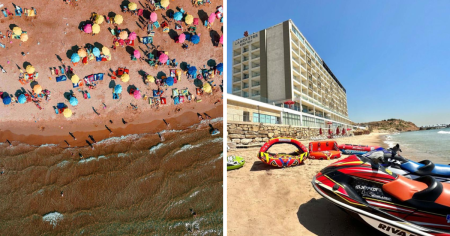
24 Sandy Beaches In Lebanon

15 Ice Cream Places In Lebanon To Cool Off

15 Dog-Friendly Beaches In Lebanon For You And Your Pup

PUBG MOBILE Is Teaming Up With Myriam Fares
Type above and press Enter to search. Press Esc to cancel.

Stepfeed is now a daily newsletter
Subscribe to get the latest news and fun happenings in the region.
A complete guide to Lebanon's Bekaa Valley
Lebanon's bekaa valley is arguably one of the most beautiful and picturesque places in the middle east..

Lebanon's Bekaa Valley is arguably one of the most beautiful and picturesque places in the Middle East. But it's also one of the biggest swathes of land in the country, and it's hard to know just where to start. In a lot of ways, it functions as its own little country. So here's a small travel guide to take you through it.

Serving as the country's primary agricultural district with lush vineyards and all manner of crops dotting the valleys landscape, Bekaa is surrounded by expansive mountains featuring breathtaking views.
If you're visiting Lebanon, your trip won't be complete without immersing yourself in the rich culture and heritage of this fertile region. And if you're Lebanese? Well, its about time you planned a weekend getaway to this incredible region. Here's a handy guide to what to do and see and where to stay.
Start in the city of Zahleh

Start your adventure in Zahleh.
If you're in Beirut, you can catch a van at Cola, possibly with a brief stop in Chtoura on the way. Tell the driver where you want to go, and he'll advise you. Overall, the price should be 7,000 Lebanese lira ($4.67). The drive from Beirut to Zahleh should take about 90 minutes, depending on traffic. Of course, if you can rent a car, ride with friends or hire a taxi for the day, these options are all more comfortable.
Zahleh is Lebanon's fourth largest city, with the downtown nestled perfectly in a gentle mountain valley. On the outskirts of the city, you can visit the Lady of Bekaa Shrine, a statue of the Virgin Mary poised high above the valley below. If you make it to the top, the valley lays out beautifully below you.

It's definitely worthwhile to take a casual stroll down Zahleh's main drag, along the Berdawni river that runs through the city. You can grab coffee, lunch or a cold beer at one of the local shops.
Visit farms and wineries

Perfect for a leisurely walk through the woods, Taanayel is located a short drive from Zahleh. You can see the farm animals, eat tasty baladi labneh or jebneh sandwiches and stroll around the picturesque lake surrounded by mountains and vineyards. For more information about the Taanayel farm call +961-8-543622 or +961-3-941004.
During the afternoon, you can swing by one of the Bekaa Valley's top-notch wineries. Chateau Ksara has been ageing wine since 1857. Located just outside of Zahleh, the historic winery gets the most attention but Chateau Kefraya , Massaya and Domaines des Tourelles are also great spots to taste award-winning Lebanese wine .
Immerse yourself in history

It goes without saying that anyone coming to Lebanon should pass by the ancient Roman ruins of Baalbek, which date back to the first century A.D. Located less than an hour away from Zahleh, the impressive monuments have weathered the test of time, standing as a testament to ancient engineering and ingenuity. The entrance fee is 15,000 Lebanese lira for tourists, reduced to 10,000 Lebanese lira for Lebanese and students.
While the Baalbek ruins are a must-see, there are several other impressive historic sites to visit in the Bekaa as well. The ruins in Anjar, which are much more recent and date to the 8th century A.D., stand as a unique architectural example of the Umayyad period . Located further north on the outskirts of Hermel, you will find the Kamouh El Hermel (Hermel Pyramid). The origins of this unique monument are unclear but it is believed to date to the first or second century B.C.

Another intriguing, albeit more modern, historic site is the Rashaya Citadel, located near the Syrian border. This national monument was built in the 1700s and served as the temporary prison of independent Lebanon's first leaders. Bechara El Khoury, who became Lebanon's first president, and Riad El-Solh, who became Lebanon's first prime minister, were held in the citadel by the French along with several other prominent early Lebanese politicians.
Eat at Tawlet Ammiq

Part of the Souk El Tayeb organization, Tawlet Ammiq is not only situated in an incredible location but also offers an succulent buffet consisting of farm-to-plate cuisine all cooked up by local Bekaa women. The buffet will cost you $44, but it is well worth the bill. It offers you some of the freshest and most delicious Lebanese cuisine you've ever had with unlimited drinks and desert included. You'll be feeling more than satisfied after spending the afternoon relaxing as you overlook the fertile valley below.
Souk El Tayeb's Tawlet branch located in Beirut has been ranked as the eighth best restaurant in the world , so you know it has to be good!

Stay at Grand Hotel Palmyra or Beit El Kroum
Day trips to the Bekaa from Beirut are definitely doable, depending on how much you want to see. However, if you have the time, why not spend a night or two to gain the full Bekaa experience?

Located across from the iconic ruins of Baalbek, the Grand Hotel Palmyra is one of Lebanon’s oldest hotels. Built in 1874, the hotel has maintained its now antique style for more than a century. In its prime, the hotel hosted royalty and the high society guests that journeyed to see the well-preserved Roman ruins.
And if you want to wake up each morning to an incredible view of the Bekaa Valley stretching out below you? Well, make it reality and stay at the Beit El Kroum boutique hotel. Perfect in summertime, the hotel features a patio and pool area, hosting regular barbecue events.

So, as you can see, whether you want to relax, explore or wow your taste buds, the Bekaa Valley is definitely the place to go. Perhaps this weekend?
You may also like
Mount arafat covered with worshippers is a sight to behold.
- Religious Tourism
- Deir el Qamar
- Plan ur trip/Contact us
Bekaa Kafra, the highest village in Lebanon
Tucked away on the highest hill in Lebanon and the Middle East, Bekaakafra is a small town whose streets are always scented with the aroma of the holy valley of Qanoubine, where the sound of canticles and prayers echo constantly…It is an exemplary town blessed by his holiness Saint Charbel Makhlouf, for his countless miracles and healings…
This village that failed to acknowledge urban life is a breath of fresh air, a haven of peace, of quiet and safety!
Visiting Bekaakafra is an opportunity to admire the chef-d’oeuvre of the Creator, the magical unspoiled landscape. It is as though this village, perched between heaven and earth, still bears the fingerprints of God…
The locals of Bkaakafra live their Christian life to the fullest and they are known for their generosity and hospitality, but also for their courage and vigor rooted in the land and history.
These people have also been famous for their kindness, sincerity, spontaneity and deep faith.
Whoever visits this town feels that he is the son of nature and feel the desire to live in simplicity.
Houses in Bekaakafra still preserve their authenticity due to their ancient and modest architecture.
Customs, traditions and ancient folklore hang around in this village, especially during evenings and anniversaries. During the week of Saint Charbel’s anniversary festivities, an exhibition of homemade products prepared by the locals takes place along the street leading to the house of the Saint. A traditional marriage is also celebrated in the fashion of the nineteenth century.
This isolated village, of 1,800 meters’ altitude in Becharreh, is inhabited by villagers who consider themselves the relatives of the Saint known in the four corners of the earth. Bekaakafra’s history dates back to the tenth century according to historian Fouad Boustany Ephram, and two thousand years according to another study. Neighbors with the Cedars of God and mentioned several times in the Bible, this village overlooks the holy valley of Qannoubine, which hosted, from 1440 to 1823, 24 Maronite patriarchs as well as hermits, monks and saints. As for the etymology of Bekaakafra, it is of Syriac origin, composed of “Bekaa” as ground and “Kafra” as rich (rich soil).
Many roads lead to Bekaakafra: Shekka – Amioune – Hadath el Jebbeh – Bekaakafra or Tripoli – Koura – Hadath el Jebbeh – Bekaakafra or Ehden – Bcharre – Deir el Ahmar or Bekaakafra – Aynata – Cedars – Bcharre – Bekaakafra.
Tourism in Bekaakafra is religious par excellence, and the places to visit are the Church where Saint Charbel had been baptized (which was built between the seventh and thirteenth centuries), the Notre-Dame Church built in 1925, the convent of Saint Eusebius, the Saint Charbel house and the grotto where Saint Charbel used to pray.
Written by Antoinette Shallita

13 Stunning Places to Visit in Lebanon
Adventurous Kate contains affiliate links. If you make a purchase through these links, I will earn a commission at no extra cost to you. Thanks!
What are the best places to visit in Lebanon? If you’re planning a trip to Lebanon, where should you go? Lebanon is a fantastic little country with so much to see!
The good news is that Lebanon is a compact country. So compact that it’s possible to base in Beirut the whole time and take day trips all over the country. That’s what I did on my trip — and it made it so easy to travel all over Lebanon while coming back to the same bed every night.
One of the things I love most about Lebanon is its cultural diversity. The population is about 45% Christian and 50% Muslim, with 18 recognized religious groups. There’s a sizable Armenian population, too, and people with origins all over the Middle East and the world.
Consequently, there are parts of Lebanon that feel very European, and parts of Lebanon that feel very Middle Eastern. Places where you can default to French and places where you’ll need to know a few words of Arabic.
Lebanon is geographically diverse, too — mountains, deserts, waterfalls, cities of all sizes. In Lebanon you could theoretically ski in the morning and lie on the beach in the afternoon! (Granted, you can only do that in the winter, so it wouldn’t quite be sunbathing weather, but I digress…)
Here are my picks for the best places to visit in Lebanon — along with how to get there, Lebanon safety information, and the best things to do in Lebanon.
Table of Contents
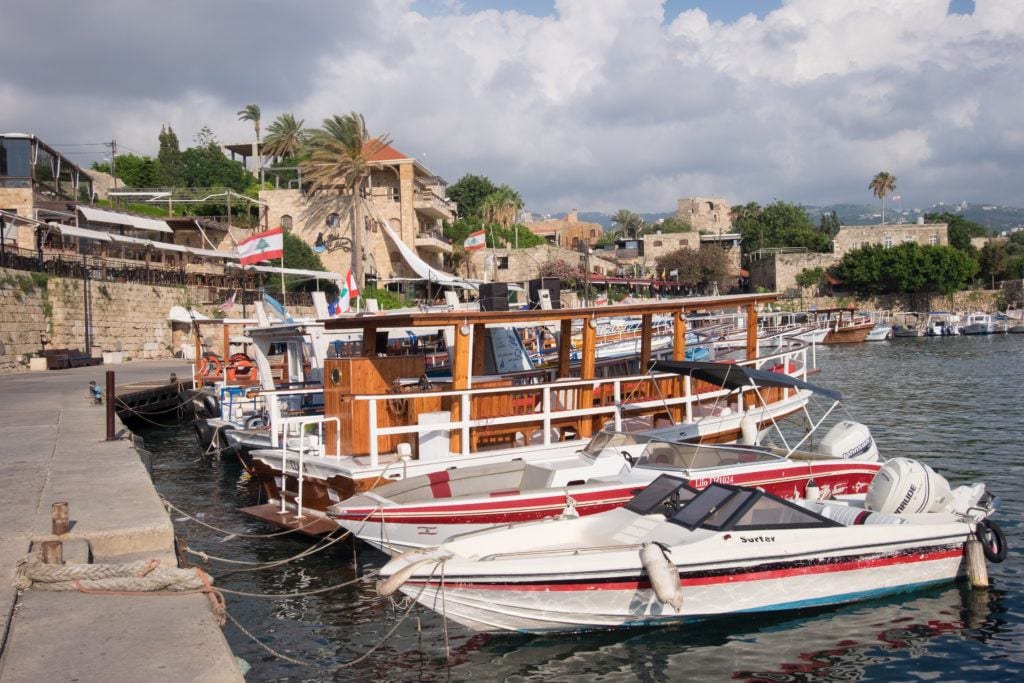
Best Places to Visit in Lebanon
All roads lead to Beirut in Lebanon, and Beirut makes a great base for your whole trip. But as far as day trips go, you have freedom to shake things up.
If you could only visit three places in Lebanon besides Beirut, I would recommend the seaside town of Byblos , the Roman ruins of Baalbek , and the small city of Tyre .
Lebanon is a lot safer than you think it is . You don’t need to worry about war or terrorism more than you do in other countries, and common sense will get you far, but it’s smart to check the latest news before you go.
Baalbek is in the Beqaa Valley, close to the Syria border in Hezbollah-controlled territory. To get to Baalbek , it’s best to hire a private driver or join a day tour from Beirut.
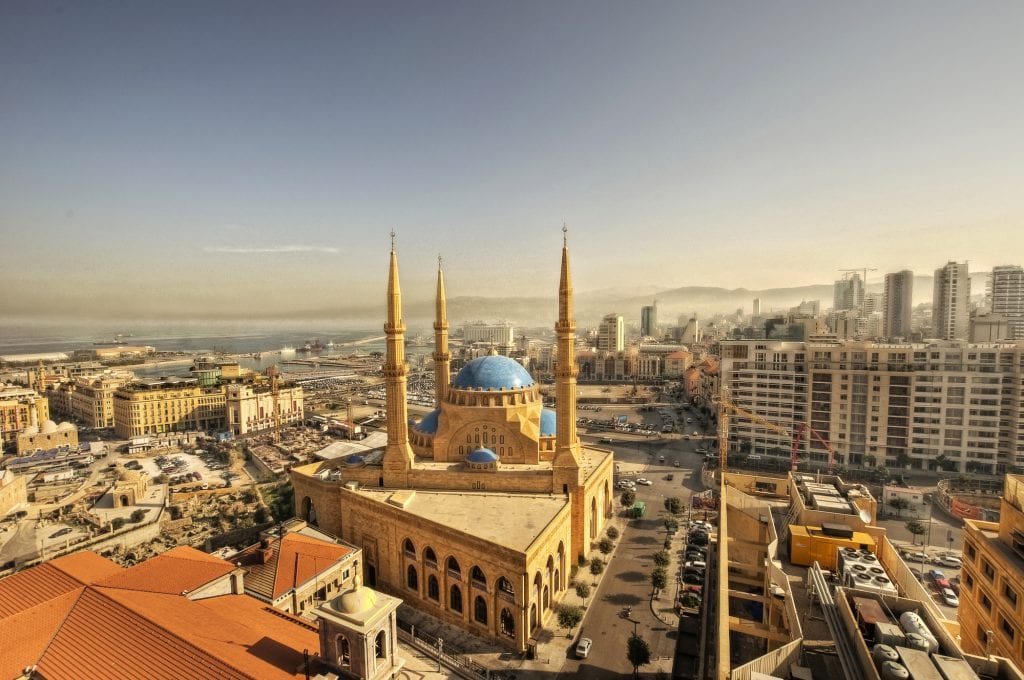
Beirut is one of the best, most vibrant, most exciting cities in the Middle East. Because it’s much more liberal than other Middle Eastern cities, there is a huge party scene, from the wild beach clubs to the roof-retracting nightclubs. But beyond the nightlife, you have centuries of history and different cultures coming together. Oh, and did I mention how good the food is here?!
Have a night out bar-hopping on Armenia Street in Mar Mikael; stroll along the Corniche in the morning; check out the cafes on Hamrun Street; visit the National Museum of Beirut; take the Alternative Tour Beirut to learn more about Lebanon from a holistic perspective; spend a day at a beach club; shop in the Beirut Souks (more a mall than souks).
How to get to Beirut: Lebanon’s land borders are closed, so the easiest way to get to Beirut is to fly. Check Skyscanner for the best rates. There are also some ferries from Cyprus.
For me, Lebanon was part of a larger trip, so I flew to Beirut from Amsterdam via Istanbul on Pegasus Airlines. On the way back I flew from Beirut to Larnaca, Cyprus, spent a few days there, and flew back to Amsterdam.
Where to Stay in Beirut: See the Where to Stay in Lebanon section below for my top accommodation picks in Beirut.
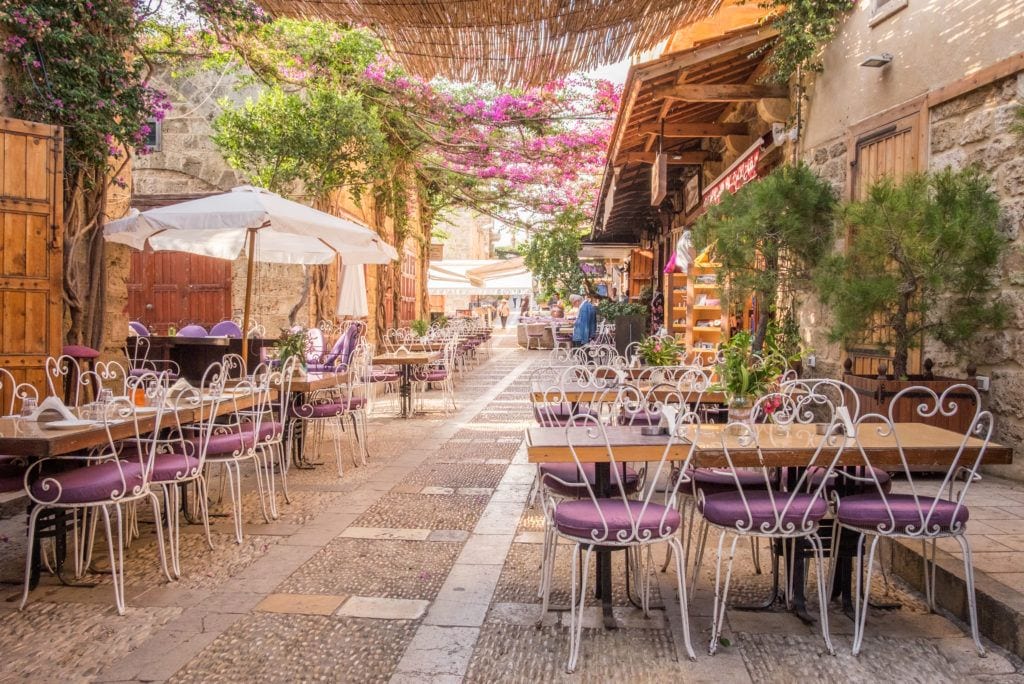
Byblos — known as Jbeil in Arabic — is easily one of the most beautiful places to visit in Lebanon. This seaside village north of Beirut looks like it could be a coastal town in Montenegro with its teal waters, palm trees, sandstone old town, and mountains rising in the background.
You might notice that the word “Byblos” is related to books — well, there’s reason for that. Byblos was a trade center for papyrus, importing it from Egypt and exporting it throughout the Aegean, distributing the earliest books.
Today in Byblos, you can visit the ruins, walk along the water, shop in the souk (now filled with souvenir shops more than anything else), or enjoy fresh seafood at one of the cafes with a water view.
Byblos is one of Lebanon’s UNESCO World Heritage Sites, designated for being one of the oldest Phoenician cities, inhabited since Neolithic times, and for helping create the Phoenician alphabet.
How to get to Byblos: Byblos is about a 45-minute drive from Beirut. It’s doable with an Uber, but you may have trouble finding an Uber to take you back to Beirut. Minibuses to Byblos (Jbeil) leave from Charles Helou bus station in Beirut, though they drop you off along the highway, about a 15-minute walk from town. This day tour from Beirut includes Byblos, Jeita Grotto, and Harissa.
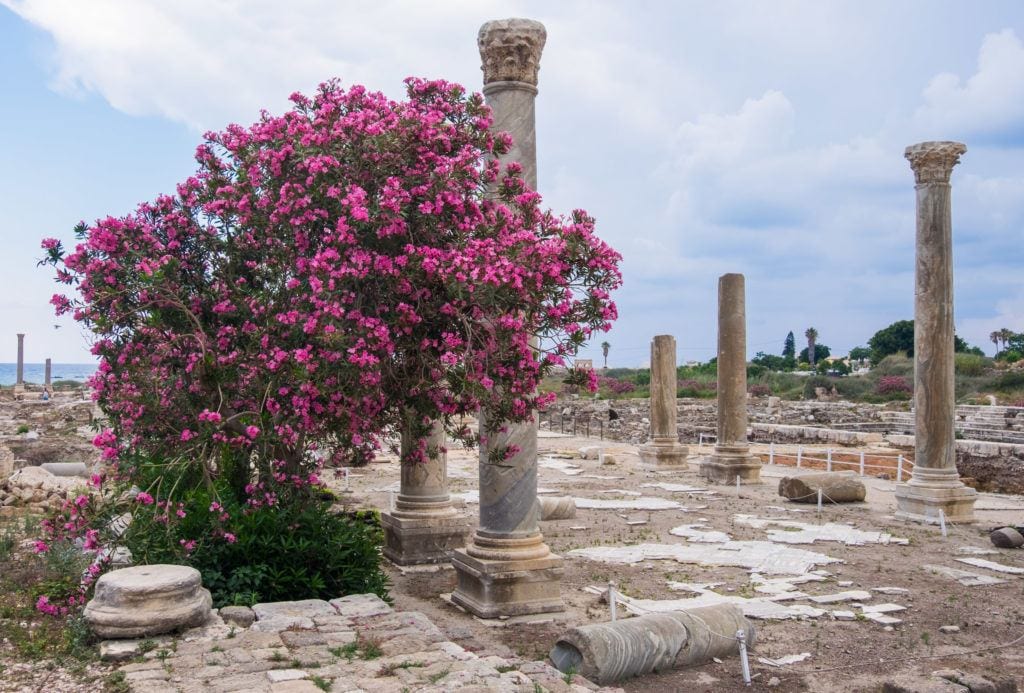
Tyre, also known as Sour (pronounced soor ), was one of the most important cities on the Mediterranean. Today, this city in southern Lebanon is home to fine Roman ruins perched up against the sea, a pleasant and walkable small town, incredibly friendly people, and fresh flowers bursting out in every direction.
Some places give you great vibes from the moment you arrive. That was Tyre to me. It was walking along the seaside and having fresh orange juice with a mother and her young son. It was being one of the few people at the ruins, wondering why it wasn’t full of tourists. It was wandering through the town and photographing each piece of it.
Tyre is one of Lebanon’s UNESCO World Heritage Sites, designated for its ancient ruins, history as a Phoenician city, founding of cities like Cadiz and Carthage — and their achievement of inventing purple dye!
How to Get to Tyre: Tyre is about a one hour and 45-minute drive from Beirut. For public transportation, the minibus to Tyre (Sour) leaves from Cola Intersection in Beirut and you may need to change minibuses in Sidon (Saida) along the way. This day trip from Beirut visits Tyre, Sidon, and Maghdouche.
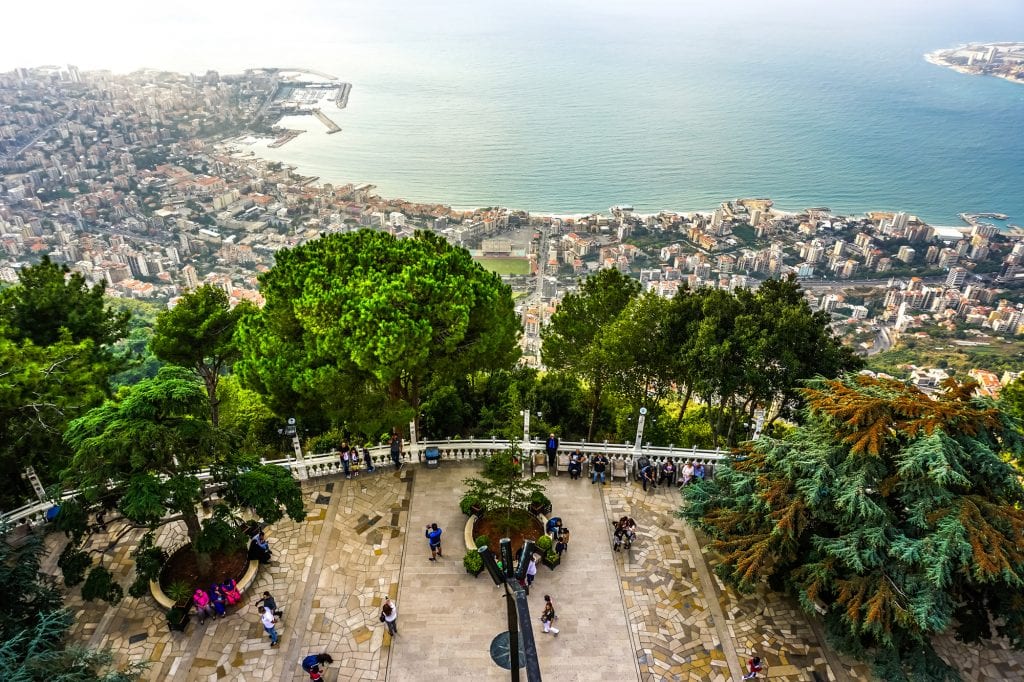
Harissa is home to one of the most famous sights in Lebanon: the Our Lady of Lebanon statue, perched on a mountaintop, seeming to look over the nation. Come to Harissa and you, too, can enjoy this Lebanese pilgrimage site — and spectacular views at 650 meters above sea level.
The Sanctuary here was created to honor the Virgin Mary — and serves as a place for peace-gathering workshops and activities between Christians and Muslims, and denominations within Lebanon’s 18 religious groups.
The most fun way to get to Harissa is to take a cable car to the top! It leaves from the seaside city of Jounieh.
How to get to Harissa: Harissa is about a 40-minute drive from Beirut. While you can drive there, you might enjoy it more if you drive to Jounieh and take the cable car to Harissa, a nine-minute journey. For public transportation, the minibus to Jounieh leaves from Charles Helou bus station in Beirut. This day tour from Beirut includes Harissa, Byblos and Jeita Grotto.
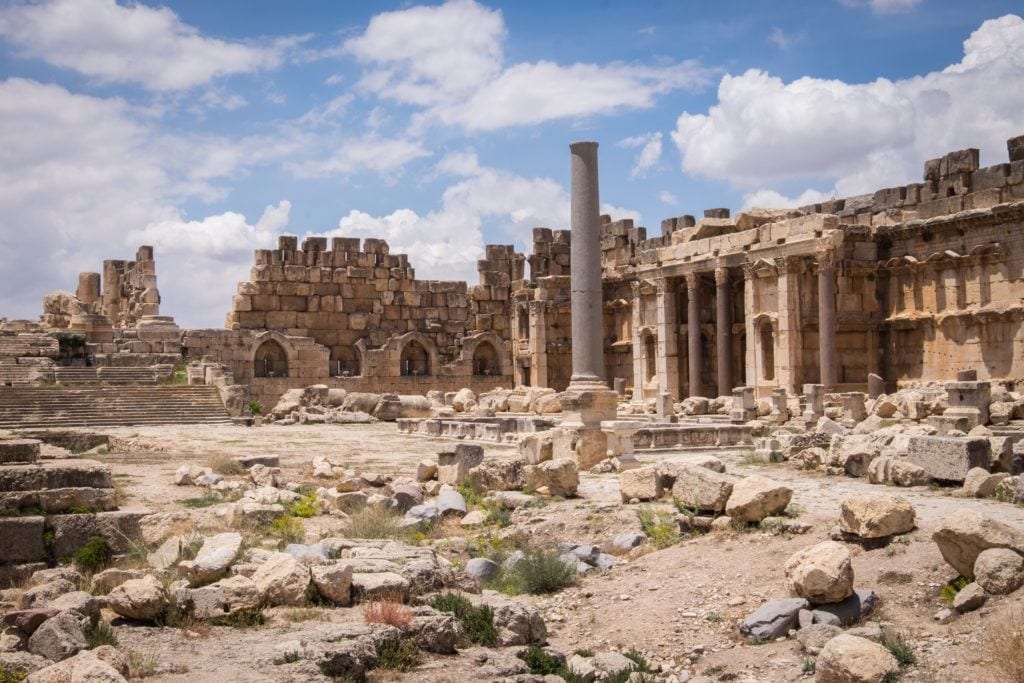
Get ready to see some of the best Roman ruins of your life! I’m not a huge fan of ruins in general, but Baalbek is home to some of the best ruins I’ve ever seen, the kind that stun you into silence. The scale alone is mind-boggling.
Baalbek is the ruins of the city once known as Heliopolis, the City of the Sun. The four temples here — dedicated to Jupiter, Mercury, Venus, and Bacchus, after Roman gods — are some of the largest remaining temples of the Roman Empire. You can also witness the two of the largest stone blocks in antiquity: the Stone of the Pregnant Woman, clocking in at 1,000 tons, and a block simply known as the megalith, clocking in at 1,650 tons!
If you’re looking to feel like an adventurer in Lebanon, there’s no better place than Baalbek. Climb to the top of the temples and enjoy the views around you, as the most powerful Romans once did.
Baalbek is one of Lebanon’s UNESCO World Heritage Sites, designated for its history as a Phoenician city and its enormous ruins, which are one of the finest surviving examples of Roman architecture.
How to get to Baalbek: Baalbek is about a two-hour drive from Beirut. I recommend spending a day exploring Baalbek in tandem with Anjar and the Beqaa Valley, possibly including a winery. This is best done with a private driver or day tour. This day tour from Beirut includes Baalbek, Anjar, and stop at Ksara Winery.
For public transportation, go to Cola Intersection in Beirut and say you want to go to Baalbek; you will be brought to a minibus to Chtaura, then you can change minibuses to get to Baalbek.
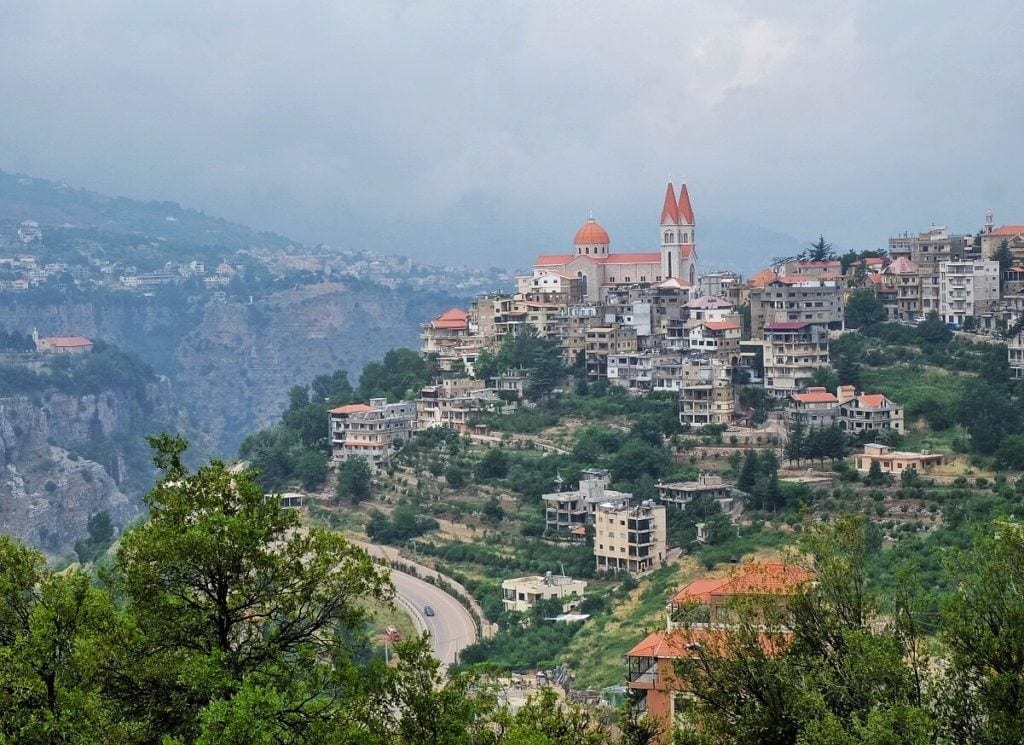
The drive to Bcharré, or Bsharri in Arabic, takes you through the winding roads of the Qadisha Valley, into river-carved canyons and mist-covered mountains. From there you’ll enjoy views that pull on your heartstrings. If you visit in the winter, you might even get to see snow.
Bcharré is famed for being the home of Lebanese-American poet, writer and artist Kahlil Gibran. The Gibran Museum was once a shelter for hermetic monks, carved into life from the rocks; today, it hosts Gibran’s tomb and a collection of his writings and drawings.
And the view above, one of my favorite views in Lebanon, it taken from the museum itself.
How to get to Bcharré: Bcharré is about a two-hour drive from Beirut. For public transportation, there is a daily minibus to Bcharré (Bsharri) that leaves from Dowra Intersection in Beirut. This day tour takes you through Bcharré, the Qadisha Valley, and the Cedars of Lebanon.
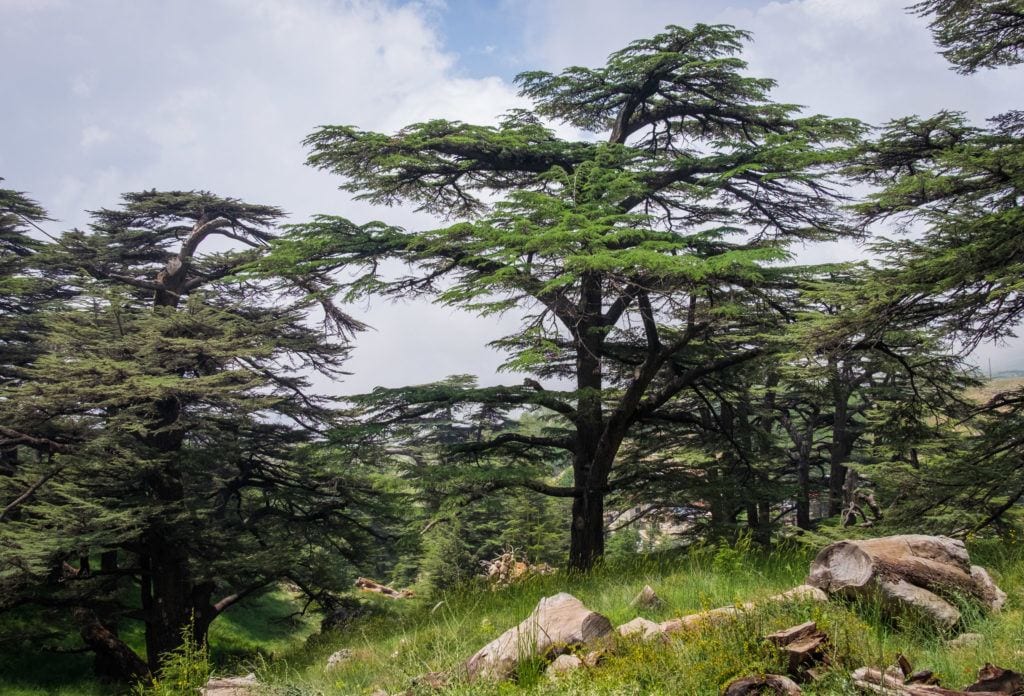
Cedars of God
Cedars are one of the most recognized symbols of Lebanon today. It proudly adorns the Lebanese flag. For centuries, these trees were lauded for their strength. The Phoenicians used their wood for boats; the Egyptians used their resin for tombs. Even U2 has a song called Cedars of Lebanon.
Sadly, there aren’t a lot of cedars remaining today. While they once covered the countryside around Lebanon, massive deforestation has led to their numbers dwindling. Cedars of God Park outside Bcharré is one of the places to see them. It’s worth visiting and hiking through the park to see their majesty up close — but seeing so few of them may leave you a bit depressed.
The cedars are fiercely protected today, however, and reforestation efforts are underway. But they take a long time to grow to adulthood, we won’t be seeing abundant cedar forests for decades.
The Cedars of God are one of Lebanon’s UNESCO World Heritage Sites, shared with the Kadisha Valley. They received this designation for their history as the most prized wood used for constructing religious buildings.
How to get to the Cedars of God: Cedars of God in Bcharré is about a two-hour drive from Beirut. For public transportation, there is a daily minibus to Bcharré (Bsharri) that leaves from Dowra Intersection in Beirut. This day tour takes you through Bcharré, the Qadisha Valley, and the Cedars of Lebanon. Alternatively, this tour gives you a full day of hiking in the Cedars .
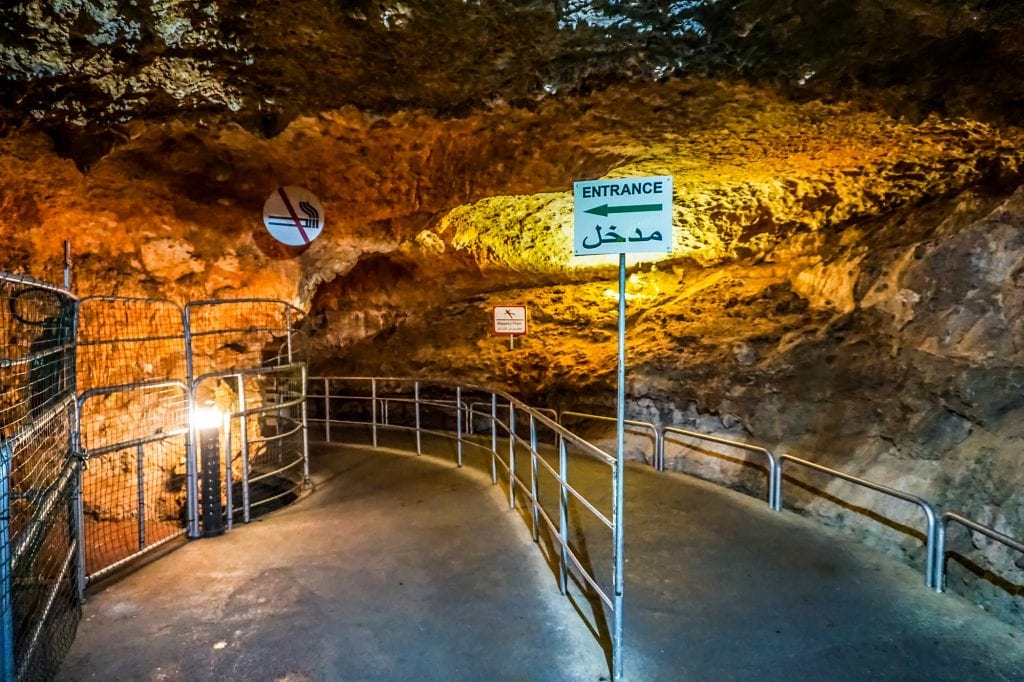
Jeita Grotto
Jeita Grotto is just outside Beirut, making it a super-easy afternoon trip (and a cool relief from a hot day!). This grotto is a system of two limestone caves. They consist of two sets of caves: the lower caves and the upper caves.
The lower caves are home to a river that provides fresh water for many people in Lebanon, and you can visit by boat. It’s a spooky but beautiful experience, especially in the boat, with the water lit up bright blue. The upper caves have a pathway to explore on foot, and they’re home to the largest stalactite in the world: 8.2 meters (27 feet) long!
Keep in mind that Jeita Grotto is VERY strict about no photos allowed. Don’t try to sneak one.
Jeita Grotto is close to Harissa and Byblos, making it a great day out to visit all three. (Though you may want to allot the most time to Byblos.)
How to get to Jeita Grotto: Jeita Grotto is about a 30-minute drive from Beirut. You can easily take an Uber there, as I did; you can’t pick up Ubers there, though, so I took a taxi from Jeita Grotto on to Byblos. This day tour from Beirut includes Jeita Grotto, Harissa, and Byblos.
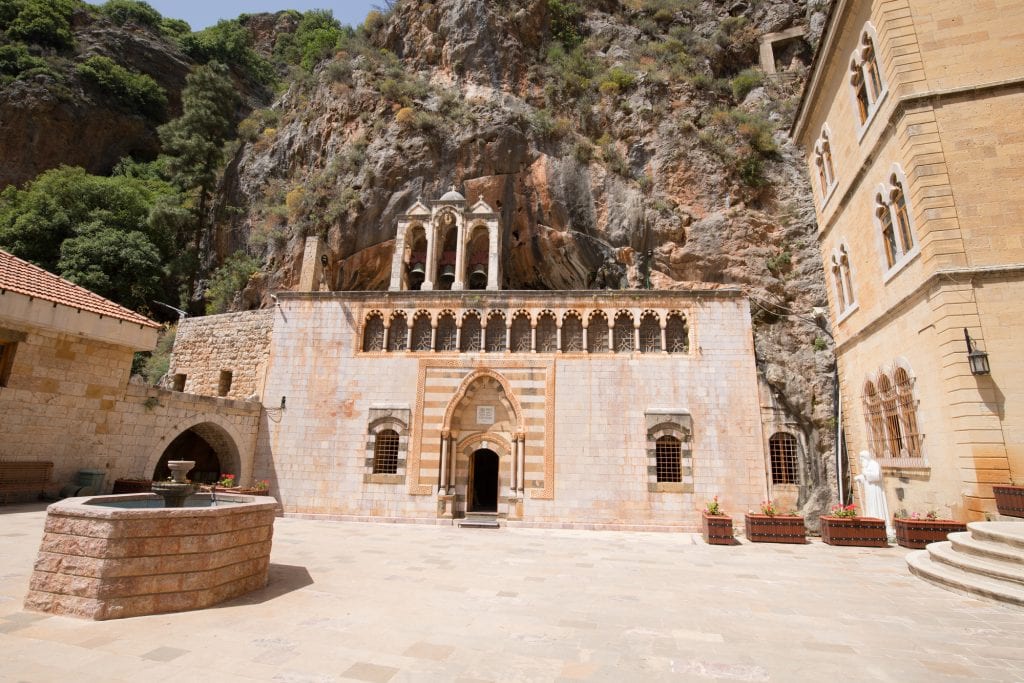
Qadisha Valley and Qozhaya
The Qadisha Valley feels like a world away from Beirut — but in a day trip you can see quite a bit of it. Mountains rise into the mist; rivers wind through the countryside, and mammoth rock faces give way to monasteries. The Qadisha Valley — also called the Kadisha Valley — was home to some of the earliest Christians fleeing persecution.
Qozhaya (Kozhaya) is one of the most important monasteries in the Qadisha Valley, and home to a convent dedicated to St. Anthony. A long drive through a wooded canyon takes you to the buildings, examples of Arabic architecture in the Middle Ages, and a rock-hewn chapel painstakingly built inside a cave.
The Qadisha Valley is one of the best places to visit in Lebanon if you’re looking to enjoy nature. Here you can hike, climb mountains, or even ski.
The Qadisha Valley is one of Lebanon’s UNESCO World Heritage Sites, designated for its history as one of the most important early Christian monastic settlements.
How to get to Qozhaya: The Qadisha Valley is about a 90-minute drive from Beirut. Qozhaya is best visited by hiring a private driver or booking a day tour from Beirut. This day tour takes you through Bcharré, the Qadisha Valley, and the Cedars of Lebanon.
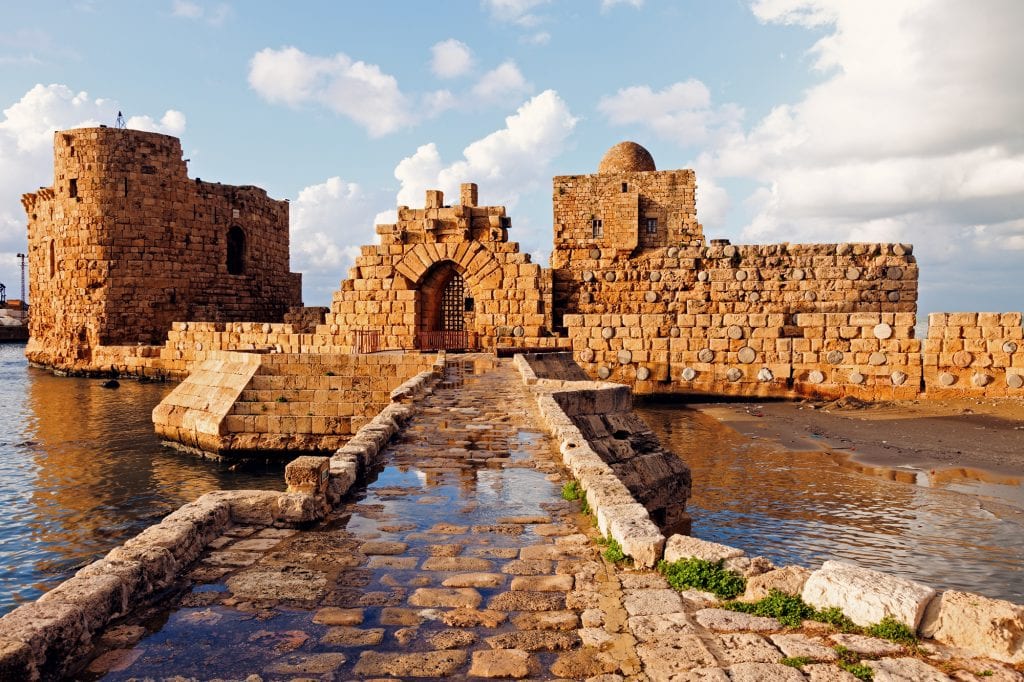
Sidon, also known as Saida, is a port city to the south of Beirut. Though it has a storied history, Sidon is one of the lower-key, calmer cities to visit in Lebanon, and one of the easier side trips from Beirut.
Sidon is famous for two places in particular: its outstanding souks, some of the most picturesque in Lebanon, which sell both traditional and modern wares in their traditional small stalls; and the Sea Castle, which was built by the crusaders as a fortress of the Holy Land.
Sidon is about 45 minutes from Tyre, so it makes sense to pair them together on a day trip from Beirut.
How to get to Sidon: Sidon is about a one-hour drive from Lebanon. For public transportation, take a minibus to Sidon (Saida) from Cola Intersection in Beirut. This day trip from Beirut visits Tyre, Sidon, and Maghdouche.
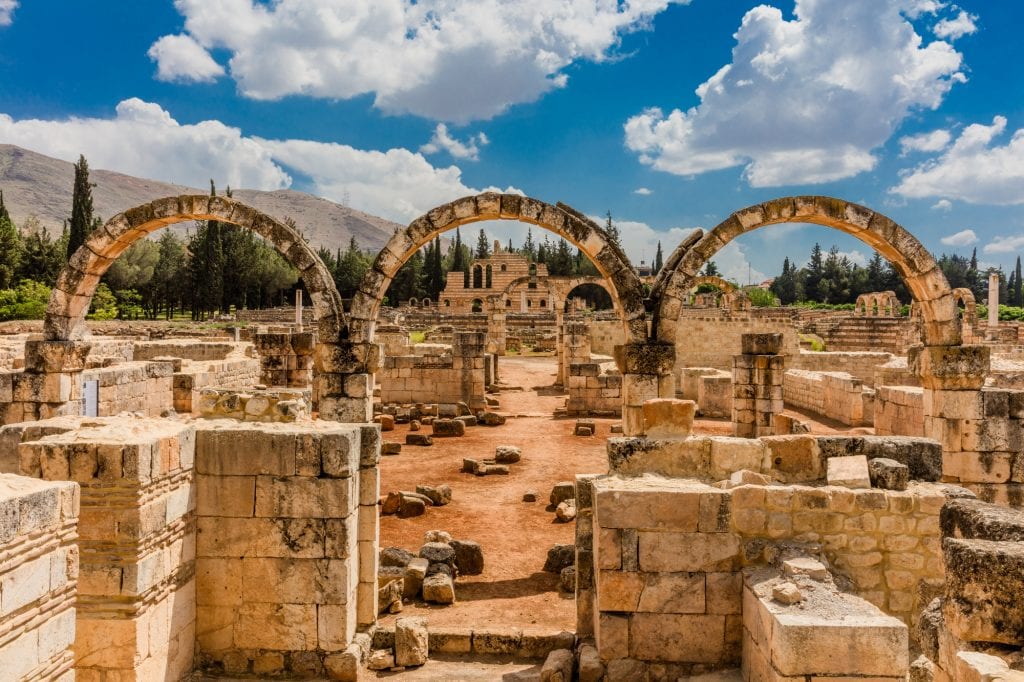
If you’re visiting the ruins of Baalbek, you should visit Anjar too — and most drivers or tours will take you to both. Anjar may not have the sweeping majesty of Baalbek, but these ruins have something unique: spectacular arches that were designed by the Umayyads. Before the Anjar ruins were studied by archaeologists, there was no other evidence of the Umayyad Caliphate in Lebanon.
Anjar’s ruins are just a stone’s throw from the Syrian border (a mountain range divides the two countries). The city of Anjar is also home to one of the biggest communities of the Armenian diaspora in Lebanon. The city is also known for its four-sided wells.
Anjar is one of Lebanon’s UNESCO World Heritage Sites, designated for its ruins, which survive as an example of city planning under the Umayyads.
How to get to Anjar: Anjar is about a 90-minute drive from Beirut. This destination is best seen in tandem with Baalbek and the Beqaa Valley, either by hiring a private driver or booking a day tour. This day tour from Beirut includes Baalbek, Anjar, and stop at Ksara Winery.
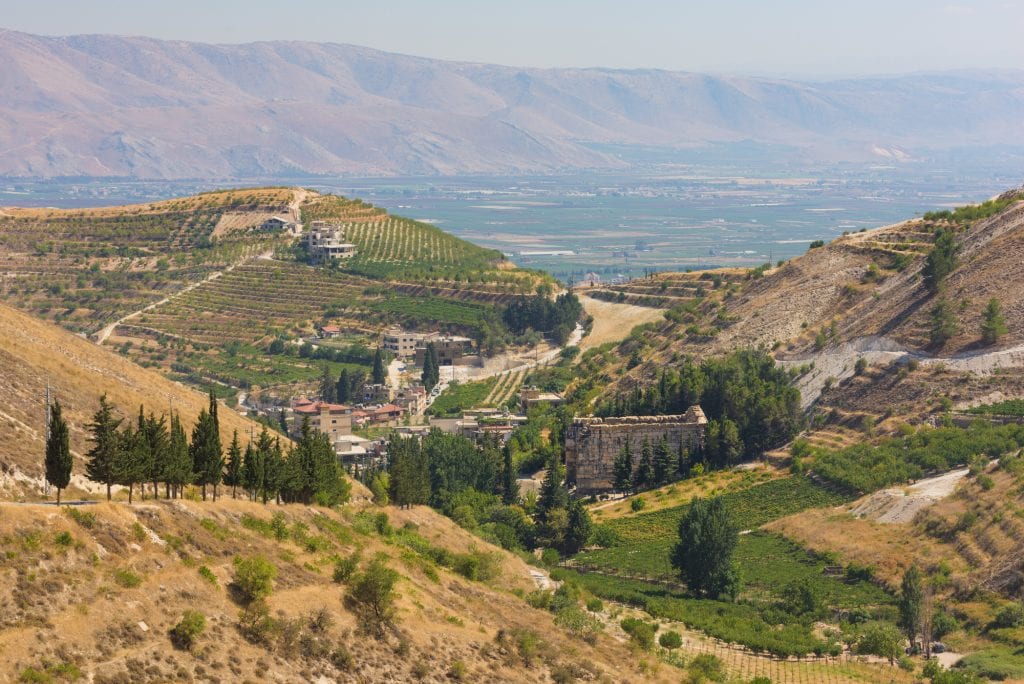
Ksara, Wine Country, and the Bekaa Valley
Did you know that Lebanon has a thriving wine scene? That might be surprising for a Middle Eastern country, but not so much in retrospective when you consider its multi-ethnic background and its location right on the Mediterranean.
The best wines grow in high-altitude areas of Bekaa Valley, close to Baalbek and Anjar. Whites are nice but forgettable; where the region truly shines is Bordeaux-style reds and dry rosés.
Chateau Ksara is one of the popular wineries and they welcome travelers for tours, tastings, and lunches. Of course, if you plan on sampling the wines, you should not be driving that day — this is a good time to come on a tour or book a private driver!
How to get to Ksara and the Bekaa Valley: Chateau Ksara is a 90-minute drive from Beirut. Many tour companies include a stop at Chateau Ksara as part of their tours in the Bekaa Valley. This day tour from Beirut includes Baalbek, Anjar, and stop at Ksara Winery. Alternatively, this wine tour spends the whole day visiting wineries in the Bekaa Valley .
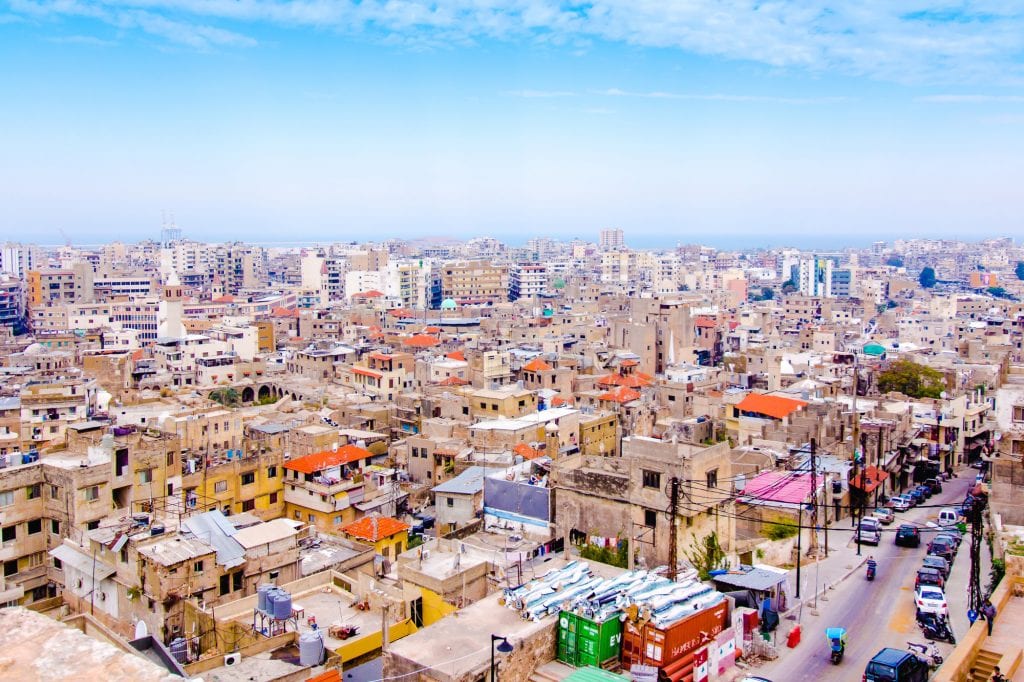
Finally, there’s Tripoli, or Trablous in Arabic — the second-largest city in Lebanon and a place that isn’t on most travelers’ itineraries. (Oh, and it’s definitely not the Tripoli in Libya!) If you do visit, though, you’ll get to enjoy a warm and welcoming city little-touched by tourism.
Tripoli has seen some hard times, and it’s one of the poorer cities in Lebanon. But there is a lot of beauty here — an Old City brimming with Mamluk architecture; dozens of souks, some of which specialize in gold or silver or fruits and vegetables or soap; and friendly locals eager to welcome you.
The El Mina neighborhood of Tripoli almost feels like another city, more like a calm seaside village. Offshore you can visit the Palm Islands Reserve and its protected turtles. Be sure to try some of Tripoli’s famous sweets (and if you’re a foreigner in the souk, everyone’s going to want you to sample theirs!).
How to get to Tripoli: Tripoli is a 90-minute drive from Beirut. For public transportation, take the Connexion bus from Charles Helou Station, which takes closer to two hours. This Tripoli day trip from Beirut gives you several hours in Tripoli, plus a stopover in Batroun or Byblos on the way back.
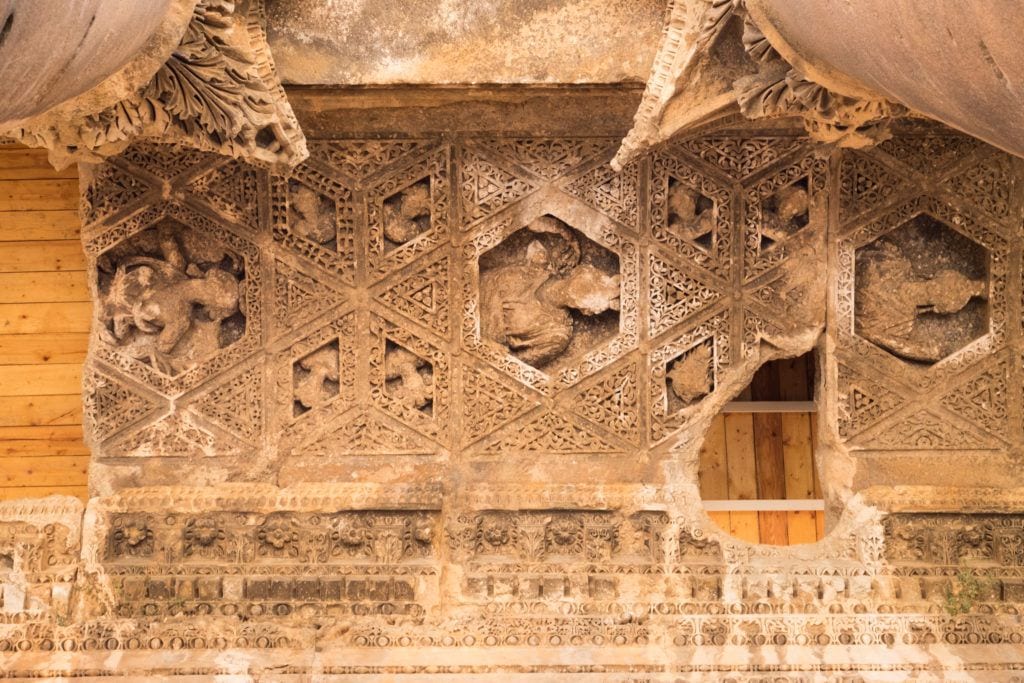
Is Lebanon Safe?
Is it safe to travel around Lebanon? Like most places in the Middle East, Lebanon is a lot safer than cable news would have you believe. The media paints the image of war, suicide bombers, and riots. Lebanon does have its problems — and has had some tough situations in recent years — but it’s not a war zone.
I traveled Lebanon as a solo woman in 2018 and didn’t feel uncomfortable at all — in fact, I was pleased with how much respect I was given as a woman. Then again, I chose not to visit Tripoli on advice from a local woman who advised me not to go alone (though other locals later told me that as an experienced solo traveler, I would have been fine).
In many ways, I felt safer as a woman in Lebanon than I have felt in many other countries. At one point, I had to sit next to a man on a minibus (usually women are sat next to women, but sometimes there’s a full bus and no other option). The man left six inches of space between us! That NEVER happened on the subway in New York!
Another issue is that part of the Bekaa Valley, including Baalbek and Anjar, is controlled by Hezbollah. When you enter that area, you pass through military checkpoints, as you do throughout Lebanon. (They are fast and easy and the guards usually have a smile for you.) Yes, it’s unnerving, especially since Hezbollah flags are for sale as souvenirs (!!), but most of the time tourists are able to visit safely.
The most important thing is to do your research before you arrive. Lebanon is not a place to arrive on a whim; doing proper research is essential. So where do you start?
I found this detailed post by Against the Compass to be an excellent resource for travel safety in Lebanon. It’s updated periodically with the latest safety information. I encourage you to save it and take a closer look before your trip.
I also recommend checking out the US State Department travel advisory and UK travel safety advice for Lebanon. I find that the US warnings tend to be more alarmist, while the UK warnings tend to be more realistic.
Most importantly, travel insurance is essential for trips to Lebanon — and to anywhere else in the world, frankly. If you need to be hospitalized with a broken bone or appendicitis, or if you have an emergency and miss your trip, or if you get robbed on a bus, travel insurance will help you recoup your financial losses. I use and recommend World Nomads .
Solo Female Travel in Lebanon: Is it Safe?
Top 10 Travel Safety Tips for Women
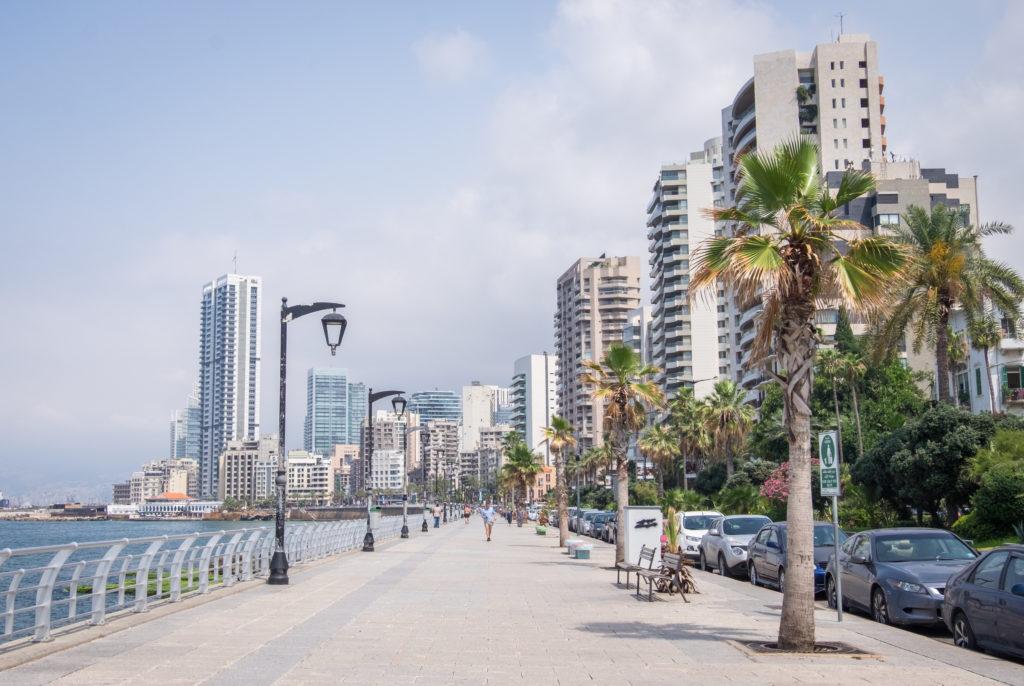
Where to Stay in Lebanon
Where’s the best place to stay in Lebanon? If you’re trying to see a lot of the country in a relatively short amount of time, it makes the most sense to stay in Beirut and do day trips. I stayed at the Radisson Blu Martinez . But there are options for all kinds of travelers.
If you want a fancy, crazy luxury experience: If you want top-notch luxury finishings and decor, go with the Sofitel Beirut Le Gabriel — it’s the best. If you want a splashed-out resort experience, go with the Movenpick Beirut , which has its own massive beach club.
If you want a small but funky local boutique hotel: The Albergo Hotel in the Achrafieh neighborhood has plant-filled terraces, local over-the-top decor, and a rooftop with a pool and outstanding views of the city.
If you want a mid-range hotel: The Radisson Blu Martinez , where I stayed, ticks all the boxes. The rooms are simple and the decor is dated, but it’s a solid option in a great neighborhood close to everything.
If you want a cheap but value-for-money place to stay: Loft 29 Residence is in the heart of the cool Hamra neighborhood, has all the facilities of apartments like laundry and a kitchen, and offers a free airport pickup in addition to very well-priced rooms.
Find deals on more places to stay in Beirut here.
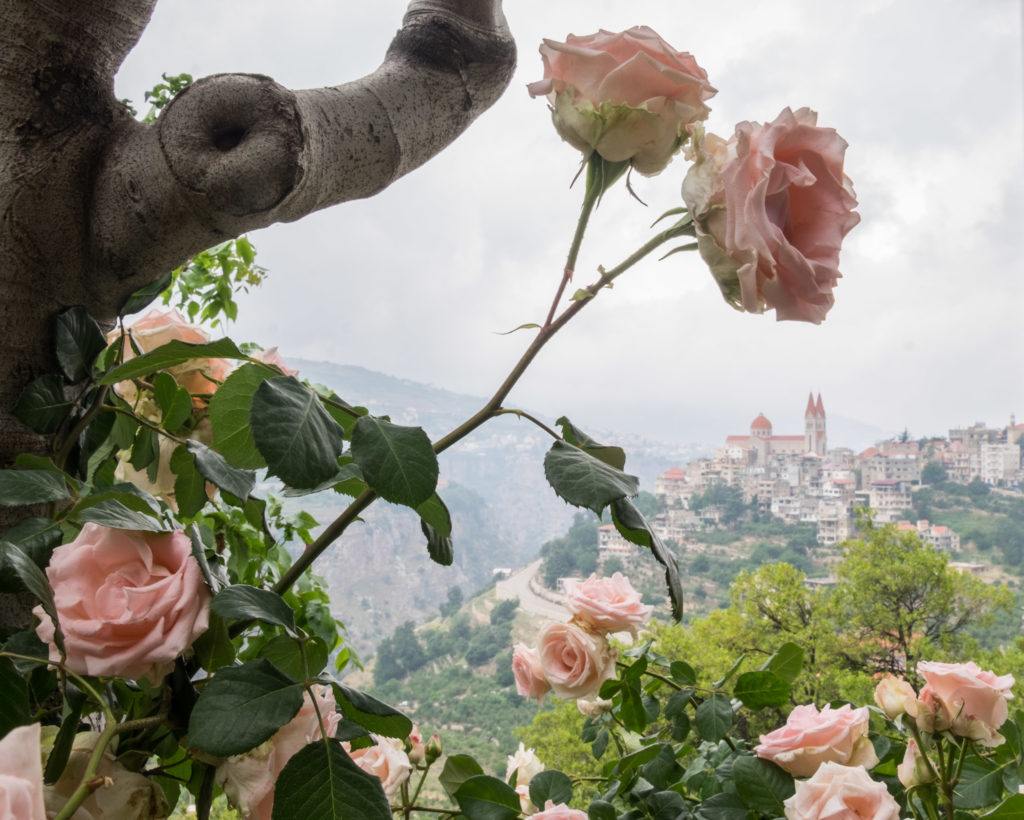
How to Get Around Lebanon
There are three main ways to get around Lebanon: you can get around by driving (either renting a car, hiring a private driver, or using Uber for short distances), you can take public transportation (mostly minibuses), or you can book organized day trips.
Should you rent a car in Lebanon? For most people, I don’t recommend it. Lebanon is home to some of the worst driving I’ve ever seen (it’s up there with Georgia and Malta). Traffic into and out of Beirut is hectic, and drivers don’t hesitate to cut across entire highways, with no warning or turn signal.
I’ve driven in lots of countries, but I had ZERO desire to drive in Lebanon once I realized how crazy it would be. You may be different, though. If you thrive in driving in erratic environments, you might enjoy driving in Lebanon.
Otherwise, there’s hiring a private driver (which can start at $150 per day and get pricier from there); and hiring one-way taxis and/or Ubers. Ubers are mainly based in Beirut, so you’ll need to use taxis on the way back.
It’s also worth noting that not a lot of drivers in Lebanon have working seat belts in their cars.
Taking public transportation is another option. Minibuses operate from Beirut all over Lebanon, departing from Cola Intersection (usually points northeast and south) and Charles Helou Bus Station (usually points north).
It’s chaotic when you get there and it seems like there are no rules! But ask where you’re supposed to go and people will help direct you. Women are sat next to women on minibuses unless there’s no other option; you pay when you arrive at your destination. Bring small bills.
I found Tyre and Sidon to be an easy day trip to do by public transportation: it’s a straightforward journey down the highway; the minibuses drop you off in town; both cities can be easily explored on foot.
Finally, there are group day tours from Beirut. I’m not usually a take-a-day-tour-on-the-bus person, but I was glad I did two tours in particular: one to the Qozhaya Valley with Bcharré and the Cedars of Lebanon , and one to Baalbek, Anjar, and Ksara Winery . Those trips would be impossible to do in a day on public transit, and they went too far for an Uber or cab driver.
More on Lebanon:
What’s It REALLY Like to Travel in Lebanon?
More from the Middle East:
Visiting Petra in Jordan
Hanging Out in Kadikoy in Istanbul
Visiting the Burj al’Arab in Dubai
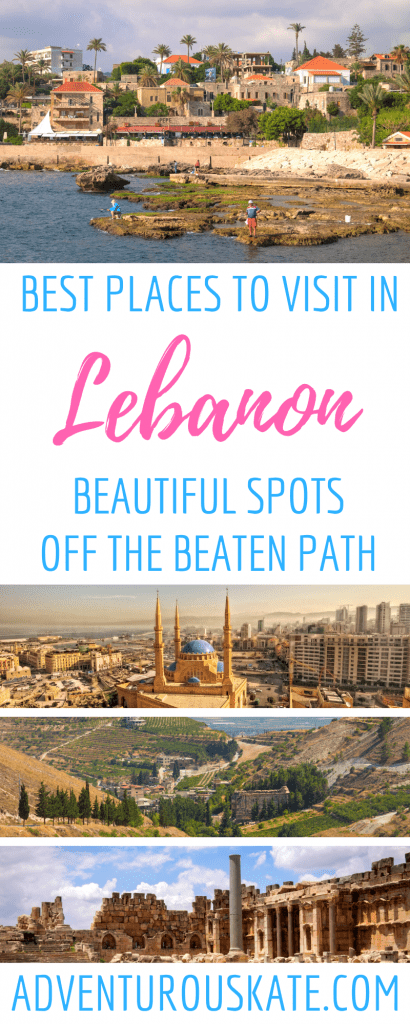
Have you been to Lebanon? What are your recommendations?
5 thoughts on “13 Stunning Places to Visit in Lebanon”
INCREDIBLE! It is like I wrote this article. I made the same trip to Lebanon in 2009 and I visited exactly the same places, cities and villages that you did (not more, not less). And in the same manner, I took only 2 different day tours, one to Qozhayah-Bcharre-Cedars and the second to Baalbek-Anjar-Ksara like you did. On the top of this, I stayed at the same hotel, the Radisson Blu Martinez where they welcomed me with their legendary hospitality. I was born in Lebanon. My parents left when I was a kid and I came back to visit my Lebanon, for the 1st time, after 43 years! What a trip it was. I am glad you enjoyed your trip to Lebanon. Regards.
Thanks for the nice impression! We, Lebanese love to receive guests. Only remark on your description of Lebanon you talk about deserts!! Lebanon might be the only Asian or middle eastern country with no deserts. Pity, that would have been a great addition to our already varied geography.
Thank you for a wonderful recount of the beautiful visit to Lebanon All places you described are very well portrayed through your pictures You only missed one magnificent area The Chouf with very Luch mountsin views the Historic Dier El Kamar beautiful Architecture from 14 & 15 Century homes & Then to the next Historic town Beit Dein with the big castle nestled in lush green mountains The Tour is g
🤲That’s wonderful, May Good keep you & fulfill race of going around the world,👋
Hi friend! How are you? Wow! This is wonderful. I have come through your story as you requested and I saw how you manage your self and you quit your job at the age of 26yrs for world traveling.In Croatia I realized that you won the Croatia’s Golden pen Grand Prix the top traveling writing award of the country of which is wonderful.
I hope your two cats Murray and Lewis and your husband are well and good. I pray for you to become the best woman world traveler and I hope you are going to do so in Jesus name.
Soon we are going to celebrate the birth of our savior of which is Christmas festival and a new year. I is to wish you a Merry Christmas and a Happy New year while traveling. Where are you going to celebrate your Christmas Eve??
May God be with you, Love you all 💞 Yours friend, Blessed!
Leave a Comment Cancel Reply
Your email address will not be published. Required fields are marked *
This site uses Akismet to reduce spam. Learn how your comment data is processed .
At least 39 killed in Israeli strikes across northern Gaza, officials say

- Show more sharing options
- Copy Link URL Copied!
At least 39 people were killed Saturday by Israeli strikes across northern Gaza, as rescue workers scrambled to find survivors beneath the rubble, according to Palestinian and hospital officials.
More than three dozen bodies arrived at the al-Ahli Hospital in Gaza City, director Fadel Naem told the Associated Press. The Palestinian Civil Defense, an emergency group active in the Gaza Strip, said its workers were digging for survivors at the site of a strike in the Shati refugee camp west of Gaza City and had pulled several dozen bodies from a building hit by an Israeli strike in an eastern neighborhood of the city.
Israel said Saturday that its fighter jets struck two Hamas military sites in the Gaza City area but did not elaborate.
The attack came a day after at least 25 people were killed and 50 wounded in strikes on tent camps near the southern city of Rafah.
Israel said Saturday that it was continuing to operate in central and southern Gaza and has pushed ahead with its invasion of Rafah, where more than a million Palestinians had sought refuge from fighting elsewhere. Most have fled the city, but the United Nations says no place in Gaza is safe, and humanitarian conditions are dire as families shelter in tents and cramped apartments without adequate food, water or medical supplies.
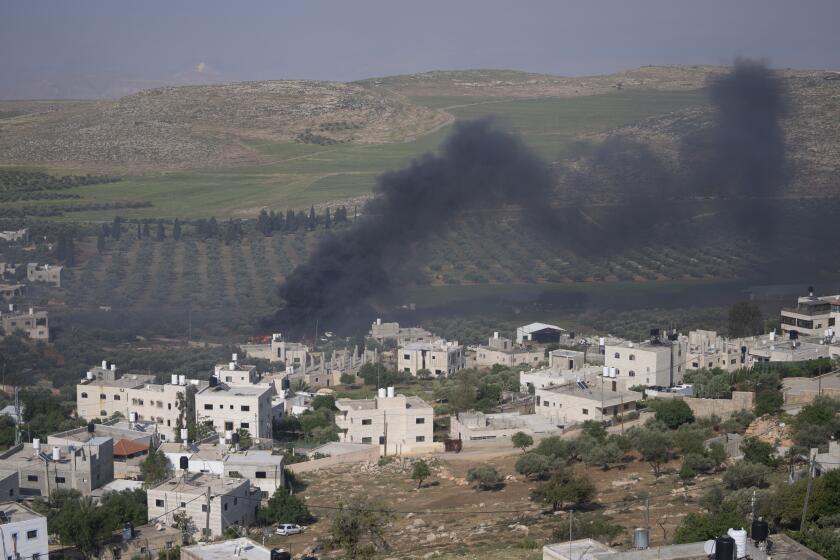
World & Nation
West Bank sees biggest settler rampage since war in Gaza began as Israeli teen’s body is found
The Israeli-occupied West Bank has seen some of its worst violence since the war in nearby Gaza began. Body of missing Israeli teen found.
April 13, 2024
A separate Israeli strike Saturday in Lebanon’s eastern Bekaa Valley killed a member of the military wing of al-Jamaa al-Islamiya, or the Islamic Group, a Sunni Muslim faction closely allied with Hamas, it said. It was the seventh group member killed by Israeli strikes in Lebanon since the war began.
The war erupted Oct. 7 when Hamas militants who stormed southern Israel killed about 1,200 people and took some 250 hostage. Israel’s response in Gaza has killed more than 37,400 Palestinians, according to the Health Ministry, which does not distinguish between combatants and civilians in its count.
Also Saturday, Israel’s army said an Israeli man was fatally shot in the northern West Bank town of Qalqilya. Israeli forces fatally shot two militants there Friday, the latest flare of violence in the territory since the Israel-Hamas war erupted.
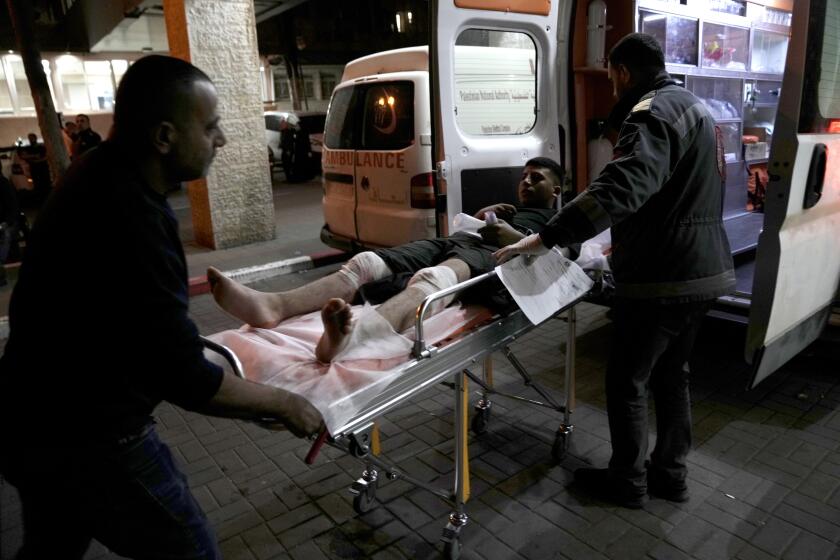
Israeli settlers rampage through West Bank village, killing 1 Palestinian and wounding 25
Three Palestinians reported killed in the West Bank by Israeli forces and settlers. Poland calls the death of a World Central Kitchen aid worker in Gaza ‘murder.’
April 12, 2024
At least 549 Palestinians in the West Bank have been killed by Israeli fire since the war began, according to the Palestinian Health Ministry. Over the same period, Palestinians in the West Bank have killed at least nine Israelis, including five soldiers, according to U.N. data.
Israeli nationals are prohibited from entering Qalqilya and other areas of the West Bank that fall under the control of the Palestinian Authority.
In April, the death of a 14-year-old Israeli sparked a series of settler attacks on Palestinian towns in the West Bank. The army said a Palestinian was arrested in connection with the killing.
On Saturday, the Palestinian Health Ministry said a 12-year-old Palestinian boy died from his wounds after being shot by Israeli forces last week in Ramallah. Commenting on the shooting, the Israeli army said its forces raided al-Amari refugee camp near Ramallah to arrest a suspect Friday, then opened fire on a group of Palestinians who were pelting them with stones.
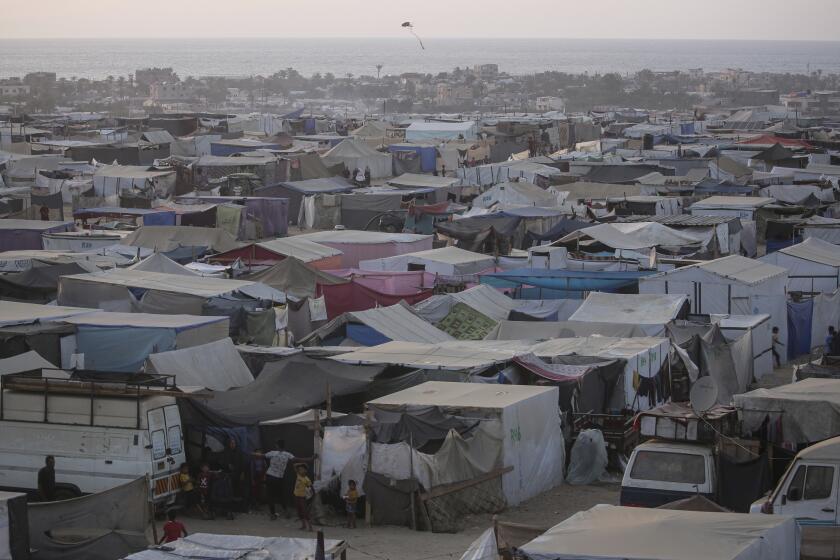
Rifts seem to appear between Israel’s political and military leadership over conduct of the Gaza war
Israeli army’s chief spokesman apparently questions the stated goal of destroying Hamas in Gaza in a rift between political and military leadership.
June 19, 2024
Israel said Saturday that it was investigating a separate incident into conduct of its soldiers after a video surfaced online showing an injured Palestinian being transported on the hood of an Israeli armored car in the northern West Bank. The army said the man in the video was a wanted suspect who was injured during an exchange of fire between Palestinian militants and Israeli forces near the city of Jenin. The man was being transported to a Red Crescent ambulance situated nearby, it said. The army said the conduct in the video didn’t “conform to the values” of the army.
Anger is growing across Israel at the government’s handling of the war in Gaza and the hostage crisis.
On Saturday, tens of thousands demonstrated in Tel Aviv, calling for new elections and for the government to bring the hostages home. Among the families were the parents of Naama Levy, an Israeli soldier who marked her 20th birthday in captivity.
Shurafa and Jeffery write for the Associated Press. Jeffery reported from Ramallah. AP writers Bassem Mroue in Beirut and Melanie Lidman in Tel Aviv contributed to this report.
More to Read

Israeli strikes on tent camps near Rafah kill at least 25 and wound 50, Gaza health officials say
June 21, 2024
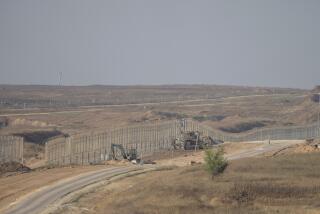
8 soldiers killed in southern Gaza in deadliest attack on Israeli forces in months
June 15, 2024

Israel bombs another U.N.-run school in Gaza, a day after strike on school killed 33
June 7, 2024
Start your day right
Sign up for Essential California for news, features and recommendations from the L.A. Times and beyond in your inbox six days a week.
You may occasionally receive promotional content from the Los Angeles Times.
More From the Los Angeles Times

After protests, UC Berkeley pledges to expand antisemitism education to all new students
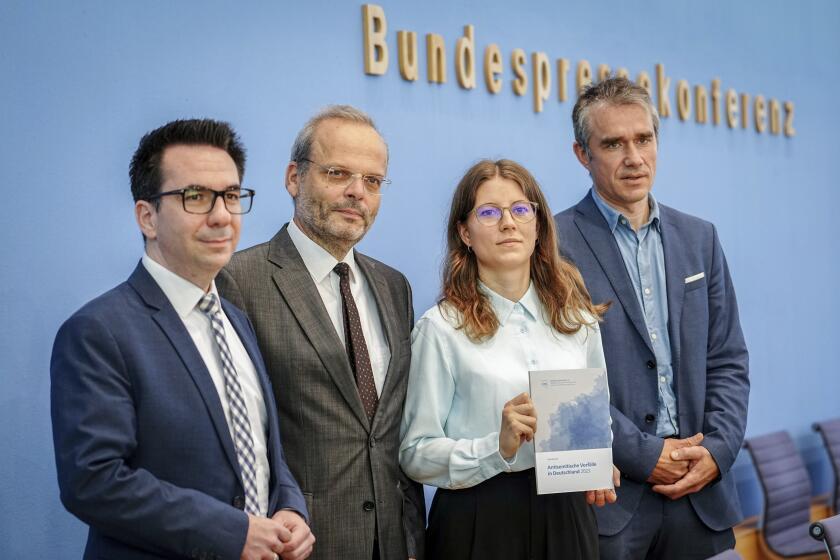
Monitoring group reports steep rise in antisemitic incidents in Germany last year
June 25, 2024
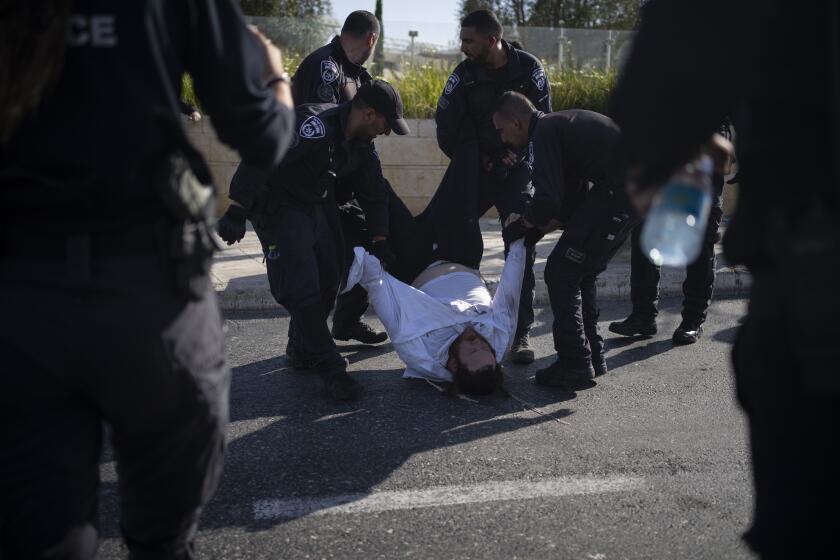
Israel’s high court orders army to draft ultra-Orthodox men, rattling Netanyahu’s government

Netanyahu says he won’t agree to a deal that ends the war in Gaza
June 24, 2024

IMAGES
VIDEO
COMMENTS
Whether you're visiting the area or just passing by, check out these 17 lovely experiences you can have exclusively in Bekaa! 1. Gaze at the marvelous Umayyad Ruins in Anjar. 2. Enjoy a day of wine tasting at Chateau Ksara, Zahle. Learn about winemaking, the ancient wine cellars, scenic vineyards, and wine tasting in the homeland of Lebanese ...
Places to Visit in Bekaa Governorate. Explore popular experiences. See what other travellers like to do, based on ratings and number of bookings. See All. Full-day Tours (66) Wine Tastings (31) ... Best Tours in Lebanon, 3-days-with Pick-up & Drop-off . 15. Historical Tours. from ₹19,218.
It's crazy to imagine how this stone was cut and also how other stones like it were moved to the Baalbek ruins. See tours. 5. Our Lady of Zahle and Bekaa. 58. Points of Interest & Landmarks. By Gaby85. Watching over the city on a 54-meter high tower is a bronze statue of the Virgin Mary, known as the Our Lady of Zahle.
I spend in Lebanon more than 7 months to travel and discover the country and there is a wonderful places to visit and to discover besides the tasty Lebanese gastronomy and sweets :) If you have the opportunity to go to Lebanon there is few places that everyone must visit, from the Bekaa Valley, Anjar, Beit Eddine, Baalbeck, Gibran Khalil Gibran ...
10. Chateau St Thomas. 32. Wineries & Vineyards. Established in 1990 by Said Touma and his family on a hill overlooking the Bekaa valley, Chateau St Thomas estate is a vineyard spreading over 65 ha & a wine storehouse for fermentation and ageing…. See ways to experience (13) 11.
When is the best time to visit Bekaa Valley? The best time to visit the Bekaa Valley in Lebanon largely depends on your preferences and the type of activities you'd like to enjoy. Here are the considerations for each season: Spring (March to May): Spring is a popular time to visit the Bekaa Valley. The weather is mild and pleasant, with ...
Things to Do in Bekaa Governorate, Lebanon: See Tripadvisor's 4,114 reviews & photos of 46 Bekaa Governorate attractions. ... Tours Add a Place Travel Forum Airlines Travelers' Choice Help Center. Middle East. Lebanon. ... Best Tours in Lebanon, 3-days-with Pick-up & Drop-off . 15. Historical Tours.
Bekaa Valley. Lebanon, Middle East. Heavily cultivated over millennia (the valley was one of Rome's breadbaskets), the fertile, pastoral Bekaa Valley is actually a high plateau between the Mt Lebanon and Jebel Libnan Ash Sharqiyya (Anti-Lebanon) ranges. It's idyllically beautiful in parts and is home to the marvellous ruins of Baalbek.
Bekaa. 1- Rafting. One of the most do sport in Hermel is Rafting in Al Assi River. Unlike other rivers, Al-Assi offers enough water depth all year round. The ride is 7 km long; you will follow the white stream for about 2 hours and a half and cross 3 waterfalls that will pump high your adrenaline. Jannet el Assi club owned by Mohamad Saab.
By mauricecN4673KH. It is a wonderful place to pray in peace and serenity. I totally recommend it for spiritual trips. 5. Chateau Rayak. 34. Distilleries • Wineries & Vineyards. By 202ghassane. The owner Elias is so friendly and so passionate that you leave the place with a quiet good knowledge about wine and...
A post shared by Al Haush (@alhaush) The Bekaa valley has several guesthouses offering people a stay surrounded by splendid nature. One of the most famous is Al Haush, which is a farm, bed and breakfast, and a farm-to-table restaurant, where people can escape the city. For more information, contact 03 911 110. Lebanon.
You can see the farm animals, eat tasty baladi labneh or jebneh sandwiches and stroll around the picturesque lake surrounded by mountains and vineyards. For more information about the Taanayel farm call +961-8-543622 or +961-3-941004. During the afternoon, you can swing by one of the Bekaa Valley's top-notch wineries.
See way to experience (1) 9. Day tour to Baalbeck Temples & Chateau Ksara winery. 44. Multi-day Tours. Enjoy a private day trip to Baalbek and Zahle from Beirut. Explore the ruins of Roman temples, visit the Chateau Ksara winery to discover ancient caves, and indulge in traditional Lebanese lunch. See way to experience (1) 10.
Tourism in Bekaakafra is religious par excellence, and the places to visit are the Church where Saint Charbel had been baptized (which was built between the seventh and thirteenth centuries), the Notre-Dame Church built in 1925, the convent of Saint Eusebius, the Saint Charbel house and the grotto where Saint Charbel used to pray.
Phone: +961 3 28 38 50 - +961 5 455 104. Email: [email protected]. Website: Ecomuseum (terbolecomuseum.com) Article edited on November 17, 2021. Loading. Bekaa Ecotourism Lebanon museums. To promote our lebanese traditional heritage an Eco Museum of Rural Life was created by the Lebanese National Heritage Foundation.
Trails are available along the water-course from the Anjar spring to its wetlands. Bicycle or donkey tours of the agricultural fields, in addition to agro-tourism activities, a picnic area, camp-sites, and a visit to observe one of the best panoramic views of the Bekaa Valley are offered. 8. Churches.
Considered as a symbol of Lebanese architectural heritage, the hotel is among a few historical landmarks hotels that still remain in Lebanon. Contact (+961 8 800 038) La Place Hotel. For people willing to make the best out of their stay in Zahle, The Palace Hotel is an excellent choice; it is located near the souks and the vibrant hub of the city.
Browse the best multi-day tours from Bekaa Governorate, Lebanon directly on Tripadvisor with itineraries and attractions to suit you. Book your Bekaa Governorate tour with confidence with our low price guarantee and 24/7 support.
10. Baaklbek and the Bekaa Valley. Tucked away in the far east of Lebanon, between the Mount Lebanon and Anti-Lebanon mountain ranges, the Bekaa Valley is one of the most epic places to visit in Lebanon. Yes, it is quite close to the border with Syria, and yes, it's generally quite safe to go on your own.
Here are 18 images of truly outstanding places around the country. Akoura - Mount Lebanon. Photos - Areej Khaddaj. Afqa - Mount Lebanon. Ammiq - Bekaa. Cedars - North Lebanon. Chouwen - Mount Lebanon. Damour - Mount Lebanon. Deir Mimas - Nabatieh.
Here are my picks for the best places to visit in Lebanon — along with how to get there, Lebanon safety information, and the best things to do in Lebanon. Table of Contents. ... How to get to Ksara and the Bekaa Valley: Chateau Ksara is a 90-minute drive from Beirut. Many tour companies include a stop at Chateau Ksara as part of their tours ...
An Israeli enemy drone targeted a car near the Lebanese town of Khiara in West Bekaa.Watch the attached video for more. ... UNIFIL Monitors Situation in Lebanon Amid Ongoing Attacks; 22 Jun 2024 13:25 ... ALSO READ. COOKIES DISCLAIMER. This website uses cookies to give you the best experience. By continuing to browse this site, you give us your ...
#2 Best Value of 38 places to stay in Bekaa Governorate Agritourism gem in Beqaa Valley, praised for farm-to-table cuisine, engaging farm activities, and picturesque setting. Exceptional hospitality, well-maintained premises, and educational experience.
Beirut Bekaa Mount Lebanon North Lebanon Regions Things We Love Where to Go. 5 Amazing Places to Visit in Lebanon. by Maria Frangieh June 17, 2021. June 17, 2021 ... Definitely a beautiful place to visit if you are in the North, especially if you want to take some really cool pictures. The resort has a capacity of 1,500 people, but they are ...
A separate Israeli strike Saturday in Lebanon's eastern Bekaa Valley killed a member of the military wing of al-Jamaa al-Islamiya, or the Islamic Group, a Sunni Muslim faction closely allied ...